Lona Manning's Blog, page 7
March 20, 2024
CMP#178 Lord Mortimer the gullible hero
 This blog explores social attitudes in Jane Austen's time, discusses her novels, reviews forgotten 18th century novels, and throws
some occasional shade
at the modern academy. The introductory post is here. My "six simple questions for academics" post is here. CMP#178 The Children of the Abbey (1796) by Regina Maria Roche
This blog explores social attitudes in Jane Austen's time, discusses her novels, reviews forgotten 18th century novels, and throws
some occasional shade
at the modern academy. The introductory post is here. My "six simple questions for academics" post is here. CMP#178 The Children of the Abbey (1796) by Regina Maria Roche
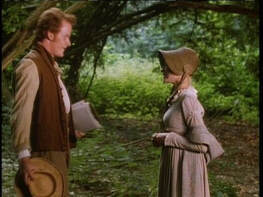 Alistair Petrie and Samantha Morton as Harriet Smith and Robert Martin in the 1996 Emma In the novel Emma, the subject of novels comes up when Emma Woodhouse asks Harriet Smith about Robert Martin's reading habits. Emma thinks the young farmer is not good enough for her friend Harriet. She asks Harriet, “Mr. Martin, I suppose, is not a man of information beyond the line of his own business? He does not read?" Note that Emma phrases the question in the negative. She's expecting to have her prejudices confirmed.
Alistair Petrie and Samantha Morton as Harriet Smith and Robert Martin in the 1996 Emma In the novel Emma, the subject of novels comes up when Emma Woodhouse asks Harriet Smith about Robert Martin's reading habits. Emma thinks the young farmer is not good enough for her friend Harriet. She asks Harriet, “Mr. Martin, I suppose, is not a man of information beyond the line of his own business? He does not read?" Note that Emma phrases the question in the negative. She's expecting to have her prejudices confirmed.There's a bit of subtle humour too, because surely Emma is asking about serious reading--politics and philosophy and history--but Harriet thinks only of novels and the Elegant Extracts (a sort of Readers Digest Condensed Books of the day). She mentions two potboilers: "He never read The Romance of the Forest, nor The Children of the Abbey. He had never heard of such books before I mentioned them, but he is determined to get them now as soon as ever he can.”
We never learn if Robert Martin ever get a copy of Regina Maria Roche’s lengthy gothic romance novel, The Children of the Abbey, but it was a best-seller. A synopsis published one hundred years after its publication, describes it thus: "The motherless Amanda is the heroine; and she encounters all the vicissitudes befitting the heroine of the three-volume novel. These include the necessity of living under an assumed name, of becoming the innocent victim of slander, of losing a will [that is, the will hidden from her by her evil stepmother], refusing the hands of dukes and earls, and finally, with her brother, overcoming her enemies, and living happy in the highest society forever after. The six hundred pages, with the high-flown gallantry, the emotional excesses, and the reasonless catastrophes of the eighteenth-century novel, fainting heroines, lovelorn heroes, oppressed innocence and abortive schemes of black-hearted villainy, form a fitting accompaniment to the powdered hair, muslin gowns, stage-coaches, postilions, and other picturesque accessories.”
It’s a long book with a lot of twists and turns, so I'll stick to the highlights and some recurring themes and tropes. The villains "are completely depraved and infamous, hardly a resemblance of humanity left in them," to use Jane Austen's words, and the heroine sheds a lot of tears along the way...
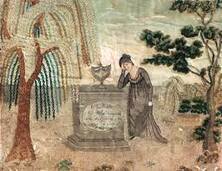 Amanda mourns her mother Our story begins....
Amanda mourns her mother Our story begins....Regina Maria Roche’s best-seller starts with a teaser chapter—we meet Amanda Fitzalan (she’s in tears, of course) as she arrives in Wales to live in the humble cottage of some retired family servants. All we know is that she is worried about her father and she is in hiding.
After the teaser chapter, we fill in with some backstory. Amanda’s father Mr. Fitzalan is the ‘’descendent of an ancient Irish family.’’ When he was a young army officer, he eloped with the oldest daughter of the Earl of Dunreath. The lovely Malvina had been, even hated, by her stepmother, who had managed to turn her father against her, in favor of her younger stepsister, Lady Augusta. Malvina had every reason to run away, but in these novels, good fortune seldom pursues girls who elope in defiance of parental authority. Malvina and Fitzalan lived in poverty and their attempts to reconcile with her father all failed. Malvina gave her husband a son (Oscar) and a daughter (our main heroine Amanda), before expiring. The travails of Amanda
Back to Amanda, now grown, living in seclusion in Wales under an assumed name. Wales, like Scotland, is a ‘’back of beyond’’ location in eighteenth-century novels, filled with quaint, rustic folk who speak in dialect.
Amanda is poor but genteel, which means there is no expectation that she would help out with the milking or the sweeping. But what to do with herself? You can’t just ramble around the forest glen wearing a plain but becoming muslin gown, sketching the sublime scenes of Nature and occasionally weeping in ‘’the calm solitude of the evening’’ day after day. Luckily, Amanda’s former servants live close to a nobleman’s house, which is empty most of the year. Amanda is given permission by the housekeeper to use the library and play the pianoforte.
The young and handsome scion of the family, Lord Mortimer, shows up unexpectedly and doesn’t waste time falling in love with Amanda, despite the mystery of her background. So does the local vicar, Mr. Howell (how can he help himself), but it’s Lord Mortimer that Amanda loves in return, though she is of course suitably diffident about it. The travails of Oscar.... and spoilers....
Meanwhile, Amanda’s brother Oscar, a fine young officer, is in Ireland, and he falls in love with Adela Honeywood, the sprightly daughter of a general. Now enter, stage left, (hissssssss) the villain, Colonel Belgrave.
This lecherous goat is the reason Amanda is hiding in Wales, and he sets out to destroy Oscar’s life too, by thwarting his romance with Adela through lies and chicanery and marrying her himself. By the way, the "evil-lecher-uses-his-money-and-power-to-threaten-the-father’s-finances,-the-son’s-army-career,-and-the-daughter’s-virtue” was used by Susannah Rowson for the parents of her heroine in Charlotte Temple, published five years earlier.
More travails for Amanda
A remark by the mother of Amanda’s host family, that Amanda "is not the first poty [body] who has met with a bad man," causes Lord Mortimer to instantly assume that Amanda is a Fallen Woman who is hiding out in Wales from shame, when in fact she’s fled to Wales to avoid the bad man. Boom, he drops her, (or as the kids say today, he ghosts her), for the first but not the last time in this novel.
This is the suspenseful point which keeps us turning the pages: OMG, can Lord Mortimer be persuaded that Amanda is faithful and chaste? There is more villainy, both from Colonel Belgrave and from Amanda’s malicious Scottish relatives, mostly in the form of compromising Amanda’s reputation. Occasionally, Mortimer investigates the accusations made against her, but events conspire to raise his doubts again. And again.
They finally reconcile and are engaged to be married. Then his own father, Lord Cherbury, throws a spanner in the works when he entreats Amanda to break off the match. He, Lord Cherbury needs his son to marry a wealthy heiress to pay off his, Lord Cherbury’s, gaming debts, so could Amanda please just disappear on the eve of her wedding without explaining why? With many tears, Amanda consents (for Lord Cherbury swears he will kill himself if she doesn’t) even though once again it blasts her ‘fair and spotless fame.’ Cheered by the unexpected light, [Amanda] advanced into the room… she found herself not by a picture, but by the real form of a woman, with a death-like countenance!... “Protect me, Heaven!” she exclaimed, and at the moment felt an icy hand upon hers! Her senses instantly receded, and she sunk to the floor. When she recovered from her insensibility … the apparition, with a rapidity equal to her own, glided before her, and with a hollow voice, as she waved an emaciated hand, exclaimed, “Forbear to go… lose your superstitious fears, and in me behold not an airy inhabitant of the other world, but a sinful, sorrowing, and repentant woman… In me,” she continued, “you behold the guilty but contrite widow of the Earl of Dunreath.”
 Scooby-Doo plot twists, image generated by Bing AI Amanda is constrained by events to move from place to place, hiding out in a convent, in a remote schoolhouse in the Hebrides, and finally, through some twists of fate, back to the old family castle, working as a governess, her identity a secret.
Scooby-Doo plot twists, image generated by Bing AI Amanda is constrained by events to move from place to place, hiding out in a convent, in a remote schoolhouse in the Hebrides, and finally, through some twists of fate, back to the old family castle, working as a governess, her identity a secret. Happy, noble and rich
There are other details I haven’t mentioned, such as the love-rival Sir Charles Bingley, a nice young man, and we should take note of the gothic aspects of Amanda’s return to the ancestral seat of the Dunreaths. While exploring the ghostly passages of half-ruined Dunreath Abbey on her own (as one does), Amanda comes across a specter! No, it’s not a ghost, it’s a female prisoner—none other than Lady Dunreath, the stepmother who so long ago made life miserable for Amanda’s mother Malvina. Lady Dunreath was locked up by her son-in-law and her evil, ungrateful daughter, to keep her from remarrying and from spilling the beans about the forged last will and testament which deprived Oscar and Amanda of their just inheritance.
Colonel Belgrave, the industriously busy seducer (he goes after several girls in this book), dies of drinking, fever and remorse in France, and Adela is free to marry Oscar.
This brings us another reminder that the theological conventions of this era bring a Reckoning at the Judgement Seat, as well as demonstrations of the highest standards of Christian forgiveness. ‘’But oh,’’ exclaims the father of one of the girls Belgrave seduced and abandoned. ‘’But oh, may he find mercy from that God! May he pardon him, as in this solemn moment I have done! My enmity lives not beyond the grave.’’ However lurid with their fixation on seduction and even assault, these novels conduce to teaching a moral lesson.
 Plot device: portraits
Plot device: portraitsPortraits and miniatures play an important role in this story. First, Fitzalan is entranced with Malvina’s portrait, and through it, he betrays his love for Malvina. The evil Belgrave uses a miniature of Amanda to persuade Adela that Oscar has another sweetheart, (when of course she's his sister), and Amanda is mooning over a sketch she has drawn of Lord Mortimer, realizing that “delicacy” demands she destroy it because he’s about to marry Lady Euphrasia: “'Oh! how unnecessary,' she cried... 'to sketch features which are indelibly engraven on my heart.' As she spoke, a deep and long-drawn sigh reached her ear... the feelings of her heart discovered, she started with precipitation from her seat, and looked round her with a kind of wild confusion. But, gracious Heavens! who can describe the emotions of her soul when the original of the picture so fondly sketched, so hastily obliterated, met her eye.” Betrayed by her feelings, Amanda confesses her enduring love for Lord Mortimer, while he reveals he is not going to marry Lady Euphrasia. About the authoress:
Regina Maria Roche (1764–1845) is ranked in the second tier of Gothic novelists, after the queen, Ann Radcliffe. Roche's 1796 novel Clermont was one of the "horrid" novels recommended to Catherine Morland by Isabella Thorpe in Northanger Abbey. Many of her novels were set in Ireland, the home of her birth. The Children of the Abbey was her biggest seller, and I think any author could be proud of a book which stayed in print for more than a hundred years, and was frequently imitated and even plagiarized.
Gothic novels continued to find a readership even as they fell in critical esteem. William Brighty Rands wrote in 1865 that "[b]ooks like The Children of the Abbey, by Regina Maria Roche, have been exposed in decent [book]shop--windows within my own recollection." In 1891, an American critic wrote: "And apparently Children of the Abbey still finds a considerable sale in this country, though it is almost wholly forgotten in England."
It seems Americans had a real predilection for melodrama, given the phenomenal popularity of East Lynne (1861) by Mrs. Henry Wood and the enduring popularity of a tale first published in 1791, Charlotte Temple.
Gothic novels favored remote settings such as Wales, Scotland and farther afield in Europe. Jane Austen did not stray beyond the home counties in the settings for her novels. As she advised her niece, who was working on a novel: ‘’Let the Portmans go to Ireland; but as you know nothing of the manners there, you had better not go with them.’’ Austen let the Dixons and the Campbells go to Ireland in Emma, but her readers did not go with them.
Previous post: Eva the runaway heroine
Published on March 20, 2024 00:00
March 14, 2024
CMP#177 Eva, the runaway heroine
 This blog explores social attitudes in Jane Austen's time, discusses her novels, reviews forgotten 18th century novels, and throws
some occasional shade
at the modern academy. The introductory post is here. My "six simple questions for academics" post is here. CMP# 177 Eva, the heroine who runs out of her own novel and disappears for quite a while
This blog explores social attitudes in Jane Austen's time, discusses her novels, reviews forgotten 18th century novels, and throws
some occasional shade
at the modern academy. The introductory post is here. My "six simple questions for academics" post is here. CMP# 177 Eva, the heroine who runs out of her own novel and disappears for quite a while
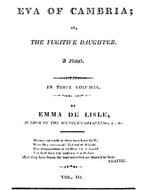 Imagine that you have written your first novel and it’s been accepted by Minerva Press, which is, let’s be honest, not a prestigious publisher but still, your novel will be published! And then it does it get published and there’s…. the wrong author’s name on the title page? I don’t know how this happened, but in later years, an authoress named Amelia Beauclerc claimed authorship of this novel, not Emma De Lisle. And why is the book called Eva of Cambria? The character Eva is absent from most of the book and she lives in France and Spain, not Wales.
Imagine that you have written your first novel and it’s been accepted by Minerva Press, which is, let’s be honest, not a prestigious publisher but still, your novel will be published! And then it does it get published and there’s…. the wrong author’s name on the title page? I don’t know how this happened, but in later years, an authoress named Amelia Beauclerc claimed authorship of this novel, not Emma De Lisle. And why is the book called Eva of Cambria? The character Eva is absent from most of the book and she lives in France and Spain, not Wales. We don't meet Eva and there is no mention of her until 185 pages into the story. We start with the history of another family; an older man named Percy Eddington, who never married because he was disfigured in a carriage accident. He lives with his spinster sister Helena, and --crash! What was that?
That was another carriage accident. This one brings a distressed widow and a lovely young lady to their door. Laura becomes Percy’s bride, in a May/September pairing. The Eddingtons are happy, devout, and kind to their tenants; good-hearted Welsh people who like to drink to excess whenever Mrs. Eddington presents her husband with a child. They have three children: Julius, Horatio, and Helen. Synopsis and spoilers follow... More Meet Cutes
Julius and Horatio go to Eton, where they rescue a girl named Arabella. First, Julius rescues her from a rabid dog, then they rescue her from a panderer who is trying to force her into concubinage. Then they head home with a family servant when they rescue our titular heroine, Eva, who is stuck at the bottom of an overturned carriage with a fat French governess standing on top of her. Eva is half-French, very young and very frightened. After subduing the horses and rendering first aid to everyone, there is nothing more two teenage boys can do, so they leave Eva and her governess with a doctor and his wife.
Because of the machinations of an evil (now deceased) step-mother, Eva knows nothing of her parentage. She despises her vulgar and ignorant governess, and fears that she is not being conveyed to the arms of a fond parent, but being taken by Madame La Botte to be given to a nobleman as his concubine. She flees in the dead of night and most fortunately is rescued and taken up by a passing couple, the Byrams, who also rescue her from an over-amorous soldier who enters her bedroom at the inn. The Byrams grow so fond of her they informally adopt her. Mr. Byram is a merchant and the family go overseas and sail out of the book for many chapters.
Julius leaves school, joins the army and goes to America (the book is set at the outset of the American Revolution) where he finds that a corporal's wife is none other than the happily married and respectable Arabella, the girl he rescued at Eton.
Back in England, the rest of the family goes on a tour around the country. Mr. Eddington by chance learns that they are near the home of an old acquaintance of his, Lord Eggerfield, who is twice widowed and living like a hermit while his estate sinks into Gothic ruin. No, that’s not a ghost, it’s Lord Eggerfield, traipsing around the halls at night. And those low moans are not the sound of an imprisoned woman--oh! wait, they are the sounds of an imprisoned woman! it’s the French governess, Madame La Botte, whom Lord Eggerfield blames for the disappearance of his daughter Eva. Mr. Eddington politely points out that it’s illegal to imprison people in England like this. Madame La Botte, who genuinely does not know what happened to Eva, is allowed to return to France.
Meanwhile Horatio rescues a reduced gentlewoman and her daughter Clara from a raging bull, and he falls like a ton of bricks for Clara. His parents aren’t the type to object to a girl just because she has no money, but Horatio and Clara are both so young, that Mr. Eddington feels it would be best if Horatio went off on a tour of Scotland to test his constancy.
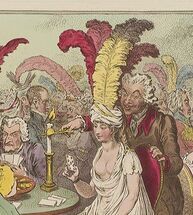 Cartoon of 14-year-old Lady Georgiana Gordon (detail) A Real P____n?
Cartoon of 14-year-old Lady Georgiana Gordon (detail) A Real P____n? At this point the author introduces a femme fatale, and because she is called Lady G_____a G____n, I concluded this must be a real person. Since the book was not reviewed when it came out, I have no confirmation, but I think it's Lady Georgiana Gordon, whose mother was a famous Scottish hostess and socialite, even though the dates don't match up. I haven’t seen a real person used in a fictional love triangle this way before. Horatio and Lady G____a meet, not beside an overturned carriage, but at a ball, where Lady G____a does her seductive “tambourine dance.”
Lady G_____a's mother the Duchess invites Horatio to her many entertainments. They speak of a pleasure cruise on the lake, and I was expecting Horatio to have to fish Lady G____a out of the water, but that never happens. Even without being rescued by him, Lady G_____a develops a crush on Horatio, who does not have the finesse to drop his prior commitment to Clara into the conversation. While disapproving of her antics (he thinks that he will never allow his daughters to do likewise), he is still powerfully attracted to her. One night the other men get Horatio roaring drunk, and he ends up kissing Lady G_____a in her boudoir. Horrified at what he has done, he flees back to his parents' house and is scrambling into the window when he is mistaken for a burglar and shot by the gamekeeper. Luckily, the wound is not fatal. When Clara is reunited with Horatio, she is so happy that she retreats, like a good Austen heroine: “a couple of hours spent alone will bring me to a proper recollection of myself; I am now all tumult, confused, and even doubtful of the possibility of such complete felicity.”
Julius and Horatio's younger sister Helen is wooed and won by a Colonel Horace Walpole, visiting on a quick trip from the American campaign.
 Name inspiration? Horatio "Horace" Walpole, (1717–1797) father of the Gothic novel Julius and some Coincidences
Name inspiration? Horatio "Horace" Walpole, (1717–1797) father of the Gothic novel Julius and some CoincidencesJulius gets badly injured in the war in America, and the ship on which he is invalided home with another officer is captured by the French. Julius and his friend Manners are paroled (meaning they give their word of honour as officers and gentlemen that they won’t escape) and given into the custody of an English merchant living in Cadiz, none other than Mr. Byram. Mr. and Mrs. Byram and Eva and their niece have been living abroad all these years. Col Manners was the drunken soldier who terrified Eva back in England in the inn, but neither the Byrams nor Eva recognize him. And he has reformed his character, thanks to Julius. Manners falls for the Byram’s niece Harriet, and Julius is entranced with Eva whom he recognizes as the girl he rescued from the carriage accident years ago (though he says nothing). He suspects she must be Lord Eddington’s missing daughter, whom he’s learned about in family letters. So what is she doing here in Cadiz? What has she been up to since she ran away? Is she a fallen woman?
After everyone is stranded in the woods because of a carriage accident, and Eva clings to him in fright, Julius can hardly restrain his feelings: “were it not for the unaccountable mystery about her, he felt that he could love her beyond measure…. Her touch had magic in it: but she might have clasped those arms about some other! Horror and disgust followed the thought.”
Finally, Julius openly questions Eva as to what she's been up to since she disappeared, and while she is briefly astonished and offended, they manage to sort things out and he proposes. But wait! Eva is French and therefore a Catholic. No worries, Mrs. Byram has converted her. Eva “read her renunciation of Popish errors." Eva learns she is Lord Eggerfield's daughter and an heiress and she ran away in error, but really, she was better off growing up with the Byrams, because her father is weird.
Julius and his friend are exchanged for French officers and they go home, bringing their affianced sweethearts with them (and Mrs. Byram as chaperone, of course). The last few chapters see them--and everyone else--married, even Madame La Botte.
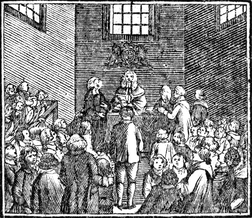 Features of interest:
Features of interest:The dramatic parts of the story are told in a fairly laid-back style, and are leavened by comic subplots. Twice, servants impersonating their mistresses elope with fortune-hunting men, thus thwarting the designs of the fortune-hunter.
No mention of slavery in this novel, and the only mention of the West Indies is as a place that soldiers wish to avoid being sent to (the climate was deadly to Englishmen). Slavery and chains are used in the conventional way of describing passion and love, as in “his lovely French enslaver.”
Lord Eggerfield mentions that his missing daughter has a birthmark, but I think the author inserted this detail into the story and never made use of it. Since Eva remembered Madame La Botte, her identity was never in question.
The book is written in 1811, long after the Americans won the Revolutionary War, but we are given the confident point of view of Julius, that the rabble will soon be suppressed. “Alas! My son,” his father thinks. “you write like a brave soldier, but not as a profound politician.”
The book is part travelogue, including a description of quarterly assizes at Newcastle. "They reached Newcastle… the Judges entered the second day after their arrival, and all was bustle, hurry, and confusion—bustle to those who take an early seat in the court, and are fond of trials—hurry to the same people who have to dine, dress, and prepare for a ball—confusion to the dismayed culprits, who stand in suspension between life and death, before clamorous counsellors and jurymen, and a gazing multitude. There is certainly something approaching to the savage, in the gaiety of the world at these awful periods; the Indian war-dance, in the sacrifice of their prisoners, bears some analogy to such meetings.”
In contrast to the many comic portraits of merchants in novels as being vulgar and pushy, Julius gives a spirited defense of them: “No character can be more respectable than that of merchant. Are they not the support of the first nation in the world? Do they not, with a true English spirit, subscribe to reward the relicts [widows] of the warrior, who has spent his last vital blood in the service of his country?”
The real Lady Georgiana Gordon married an English nobleman. She and her mother were quite colourful characters. When Eva of Cambria came out, Lady Georgiana was married and the mother of five children. But the book was set thirty years earlier, in fact when Lady Georgiana was a glint in her father's eye.
 Bing AI image conception of Amelia Beauclerc About the Author
Bing AI image conception of Amelia Beauclerc About the AuthorAmelia Beauclerc has created a large cast of characters, from nobility to servants. The heroines are all of peerless virtue but other female characters have flaws and foibles. She's not so talented with dialogue. The main characters all sound the same.
We also have a comic reference to how Madame La Botte's husband beats her "soundly," and a minor character, a woman who is psychologically disciplined into being a proper wife. Her husband was "determined to make a total reform in her Ladyship; and the preliminary article was to be, that he should be master. He was too much of a gentleman to think of using his wife ill; but, as a gentleman, he determined she should respect him, and to be firm against arts, hysterics, or blandishments.”
Despite the title, the protagonists in this novel are the men of the Eddington family, the father and his sons Julius and Horatio. The author is interested in war, travel and horses. We have scenes set at Eton, in male drinking parties, and on board ship. One could hypothesize that "Amelia Beauclerc" was a dude.
The Orlando database of Women's Writing says that Beauclerc's novels were of "oddly varying quality," Possibly, "Amelia Beauclerc" was an all-purpose pseudonym used by the publisher for novels from various aspiring writers. The other pseudonym, Emma De Lisle, was used by Emma Parker, of Wales.
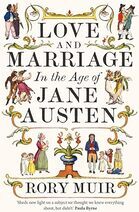 Did men and women only meet because of carriage accidents and runaway animals? Historian Rory Muir has a new book out about marriage and courtship in the time of Jane Austen.
Did men and women only meet because of carriage accidents and runaway animals? Historian Rory Muir has a new book out about marriage and courtship in the time of Jane Austen. This article from Human Progress points out that as human prosperity rises, people stop laughing at the idea of wife-beating:
Previous post: Elfrida, the martyr to rectitude
Published on March 14, 2024 00:00
March 6, 2024
CMP#176 Elfrida, the sanctimonious heroine
 This blog explores social attitudes in Jane Austen's time, discusses her novels, reviews forgotten 18th century novels, and throws
some occasional shade
at the modern academy. The introductory post is here. My "six simple questions for academics" post is here. Lately, I've been reading and reviewing lots of old novels, for reasons I'll explain later. CMP#176 Elfrida, or, Paternal Ambition (1786), a novel in two volumes by a Lady
This blog explores social attitudes in Jane Austen's time, discusses her novels, reviews forgotten 18th century novels, and throws
some occasional shade
at the modern academy. The introductory post is here. My "six simple questions for academics" post is here. Lately, I've been reading and reviewing lots of old novels, for reasons I'll explain later. CMP#176 Elfrida, or, Paternal Ambition (1786), a novel in two volumes by a Lady
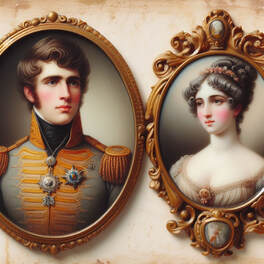 Marrying for love. Bing AI Image Elfrida, or, Paternal Ambition might be a candidate for academic analysis as a female-written story which quietly subverts the patriarchy, because while the heroine displays conventional heroine behaviour, at times she and other female characters rebel against their restrictive gender roles. We also have an interesting and nuanced (for the times) portrayal of a villain. But otherwise, this story was a disappointment. It began in a sprightly, almost comic fashion, but devolved into a weird, boring melodrama with characters moving from here and there with nothing resolved. At the end of this post, I'll share my evidence for why I think Jane Austen read or at least knew about this novel.
Marrying for love. Bing AI Image Elfrida, or, Paternal Ambition might be a candidate for academic analysis as a female-written story which quietly subverts the patriarchy, because while the heroine displays conventional heroine behaviour, at times she and other female characters rebel against their restrictive gender roles. We also have an interesting and nuanced (for the times) portrayal of a villain. But otherwise, this story was a disappointment. It began in a sprightly, almost comic fashion, but devolved into a weird, boring melodrama with characters moving from here and there with nothing resolved. At the end of this post, I'll share my evidence for why I think Jane Austen read or at least knew about this novel.Elfrida starts with the courtship of Elfrida's parents. Her mother Ella Cluwyd is a lovely girl who falls for the dashing, handsome, but poor Lieutenant Overbury. The lieutenant is such a dish that Ella’s two spinster aunts, who want to thwart the match, get a crush on him, and one of them actually proposes to him. This section is comic, in its quaint way.
Ella is living with the aunts because her father is having a dalliance with a young woman. On the eve of her father’s wedding to this second wife, Lieutenant Overbury discovers a plot hatched by Mr. Cluwyd’s valet to rob the family and kidnap the lovely Ella for the fate worse than death. Overbury, with his sergeant and other soldiers, foil the plot. Even this heroism does not win Overbury the hand of Ella, especially not when a local baronet makes an offer for her...
 Schoolyard love triangle. Bing AI image Teenage Love Triangle
Schoolyard love triangle. Bing AI image Teenage Love TriangleElla’s evil young stepmother is not pleased but incensed at the idea: “the chit she had chased from her house… to become a lady, take place of her wherever they met, and carry off the richest man in the county; forbid it malice, envy, revenge, every dire passion!” So, unexpectedly, stepmom becomes an advocate for Ella running away with the lieutenant and deceives them into thinking that Mr. Cluwyd will forgive her and support them financially. He doesn’t, so Mr. and Mrs. Overbury are condemned to a life of poverty on a lieutenant’s half-pay. They raise a lovely daughter, Elfrida. That's the prologue...
Lieutenant Overbury, who was adorable in the prologue, now becomes a tyrant. He is determined that his daughter will have a better life than he was able to give his family. When one of the spinster aunts offers to adopt Elfrida, educate her, and maker her an heiress, he hands his daughter over to her, despite the tearful objections of Ella.
Elfrida is raised on the Cluwyd estate, now re-named Arcadia, and the spinster aunt insists on a co-ed education with two neighbor boys—Frederic Ellison, who is a sadistic bully, and Edmund Wilmot, the vicar’s son, who is all perfection. “The same masters attended the three children.” They study “dancing, painting, music [and] geography” together. Of course Edmund (usually called Wilmot) and Elfrida fall in love as they grow up. But Elfrida sees the walls of propriety closing in on her: “I cannot, however, Wilmot, put on all my fetters at once; my looks, my words, my actions to be fettered, it is too much; and ah! how needless, to oblige me to conceal what passes in my poor heart.”
The aunt marries Frederic the bully's widowed father, uniting the estates, and they decree that Elfrida must marry Frederic (hereafter called Ellison). Counting on two inheritances, Lieutenant Overbury agrees to dispose of his daughter this way. Elfrida shows a bit of spirit and resists for a while. She openly declares her love to WIlmot: “I have ever loved you, and will ever love you… appearances, you know, must be attended to; I feel them, and I will not hesitate to call them so many fetters, and as such I am bound by them, but my mind is free, exteriors cannot affect that, and while I have consciousness it will be all your own.”
Lieutenant Overbury pressures Wilmot to go away so Elfrida can forget him. Elfrida submits and marries a man she has no respect for. “Wilmot has forsaken me, betrayed me, and I will not complain. My father and mother shall have their victim of filial obedience, they shall complete their cruel kindness, they shall see the insufficiency of wealth to support such a heart as mine; for Wilmot, the advocate of all that spoke peace to the jarring passions, Wilmot, that saved, now destroys.”
Once married, she behaves impeccably as a polite and submissive wife. Wilmot resolves to leave the country but first, he discovers that Ellison has seduced a nice girl, had two children with her, then abandoned her to die penniless. He rescues the children from being taken to the workhouse, and gives Hannah Jenkins, a local villager, funds to take care of them. Hannah used to be a servant to the Cluwyds and she is a typical stock servant--fiercely loyal, garrulous, and outspoken. The running comic gag with her is that it takes her forever to explain something.
 Woman's work A miserable marriage
Woman's work A miserable marriageAnyway, Ellison, now the heir to his parent’s estate, promptly squanders and gambles away all of his patrimony. Elfrida, as a matter of duty and rectitude, hands over her inheritance from the spinster aunt, which he loses. Now they are penniless and she goes to live with her parents. The loyal (and garrulous) Hannah insists on living with them, though they can barely afford to feed her, let alone pay her. Lt. Overbury is of course distraught and remorseful over the utter failure of his hopes and ambitions for his daughter. She is saintly about it, and immediately sets about earning money. “Tambour, embroidery, netting, I am perfectly mistress of; and, O, insult me not so far as to call it degrading.”
Edmund Wilmot, meanwhile, is preparing to make a return trip to the East Indies, where he has already earned a little money. “the idea of [Elfrida] working for her living, as she calmly called it, made him frantic,” but she would be dishonoured if he gave her money. At a coffee shop in London, he overhears Ellison arguing with another man, Lord S___. Lord S____ offers to forgive Ellison’s gaming debts if he can have his way with Elfrida. That’s the one thing Ellison won’t stand for, so they duel. Wilmot intervenes, but Lord S____ is wounded. Ellison escapes to America.
Lord S____ does not give up his designs on the virtuous Elfrida and expends a lot of time and energy in his efforts to have her. He befriends the family under a false name. He hires a panderer to pose as a nice widow lady to befriend them while they live in Portsmouth, and invites Elfrida and Hannah to go on a day’s pleasure cruise. He waits through five weeks of unsuitable weather, and finally, they set sail.
Once on the open waters, Lord S____ makes his intentions clear, and Elfrida contemplates whether she needs “to throw herself into the sea,” but “condemn[s] herself with the utmost severity for despairing of the protection of Heaven.” Meanwhile, Hannah manages to speak to the pilot and boatswain of their little craft and promises them a rich reward from Mr. Wilmot when he returns from India, if they assist. Turns out they know Mr. Wilmot and think he's a great guy! The pilot hails a passing ship, and Elfrida is hauled aboard, between her fainting fits. “A glass of water,” she says, [feebly, no doubt] “would be a cordial for me.”
 Happy Ever After? Bing ai image A Blessed Release
Happy Ever After? Bing ai image A Blessed ReleaseWhen introductions are performed, and Captain Venables learns that Elfrida is the wife of Frederic Ellison, he tells her that her husband was recently killed by “Indians” in America. The family writes to the British Army in America to double-check and the information is confirmed. Elfrida is now a widow, but out of delicacy, she will not stand for any talk of Mr. Wilmot. The Overburys warn Hannah not to “distress our Elfrida.” “A fiddlestick of distress,” [replies the garrulous Hannah] “I say distress, indeed, to be beloved by one of the most handsomest, and the most worthiest men in the world; for my part, I think your fine-lady whims are the next thing to lunacy…”
Well, of course Edmund and Elfrida get married, after much vacillation and delicacy on her side. He has enough money to purchase the Grange, the property that Ellison gambled away. They give a home to Ellison’s two illegitimate children. Good place to finish the novel?
Oddly, no.
Eight years go by. Mrs. Overbury’s father returns to Arcadia, he apologizes for allowing his second wife to alienate him from his daughter, he re-writes his will, and has a touching reunion with the Overburys and the Wilmots and their three lovely children, his great-grandchildren. Good place to finish the novel?
Not yet.
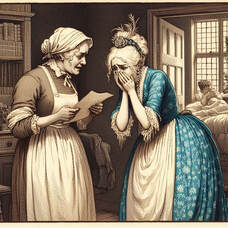 Hannah has bad news. Bing AI image Part three
Hannah has bad news. Bing AI image Part threeSix months later, Hannah receives a letter from -- oh no, it can’t be! Yes! Ellison is still alive! He wasn’t killed by Indians, he was abducted and he lived with them for seven years!
Several pages of hysterical lamentations follow, because this means Elfrida has been living in a state of adultery. She barely takes time to say farewell to Wilmot, the children, and her parents, before she flees to hide herself in London. Though she can never live with Edmund again, she wants to stay away from Ellison. Hannah grabs “a bottle of hartshorn” (yes, I think she’ll be needing it, Hannah) and offers to go with her, but she’s needed to take care of the children.
The kids, no doubt traumatized, are left with their grandparents the Overburys, while everybody else scatters. Wilmot takes his broken heart to America. Ellison also goes back to America, and then Elfrida leaves London and goes to her parents, and then Wilmot and Ellison run into each other in an officer’s mess in America, fight together, and--get this--become friends, Ellison is gravely wounded by an “Indian’s” poisoned arrow-head, and Wilmot nurses him and takes care of him as they head back again to Arcadia, where Ellison takes up residence. And then Wilmot goes to London.
The best I can say for this section of the novel is that the author does portray how a person who has done bad things always tries to justify himself. He is not a moustache-twirling villain; he regrets everything that’s happened, but he still thinks he’s been hard done by. He literally forgot that he had abandoned his two children by the girl he seduced. The children were raised by Hannah and the Overburys. Instead of showing gratitude, he is bitter at Hannah, whom he blames for poisoning his children’s minds against him.
Ellison's daughter weeps when she is told it is her filial duty to attend his sick bed. “If my behavior is sinful, he must answer for it, not me, for he has frighted all tenderness for him from my heart… [she tells Hannah], if I have no great love for him; for, if he is nothing to me, pray what am I honestly to him?” And after all, Ellison's wife, Elfrida, that is, won't come near his deathbed.
Wilmot as usual is kind and forgiving “I, nevertheless, pity him—forgive him, and charge the contraction of his vices, and the obscurity of his virtues, upon a wrong education.” Which is not to say this is all water off a duck’s back to poor Wilmot; he goes quietly insane, but recovers himself.
 The Pybus Family, Nathaniel Dance-Holland This time for sure
The Pybus Family, Nathaniel Dance-Holland This time for sureThis section of the novel closes with Ellison’s death, which leaves Elfrida a widow for sure this time. Hannah’s eulogy for him goes thusly: “because he could not be happy himself, [he] took unending delight in destroying the happiness of others, but it was very good of him (she must needs acknowledge) to come and die amongst them, to prevent all doubts and demurs hereafter.”
It occasionally happens that a writer creates a character who develops a life of her own and takes over the story. This happens with the garrulous servant Hannah Jenkins. She pushes more and more to the fore in the novel, and provides a loud, insistent counterpoint to the sentimental conventions upheld by Elfrida. Hannah is having none of Elfrida’s sanctified heroism: “wanting to teach her [that is, Hannah,] sentimentals and dickorums [decorums]—and not to be joyful when she was glad, and sorrowful when she was afflicted—or angry when she was misused—or to hate her enemies, all which was against nature, law and conscience.” I was reminded of the novel Clarentine , and the wise old widow who tells Clarentine when she is being ridiculous.
Another notable thing about this section is that Elfrida becomes more and more unsympathetic because of her "principles of rectitude," which somehow end up with her coming and going as she pleases and abandoning all responsibility. Why is it the height of rectitude to refuse to comfort your husband while he dies, but then, after he dies, insist on a six-month mourning period before re-marrying the man you love and resuming family life with him and your young children? (Her mother persuades her to cut it down to four.)
The author describes Elfrida’s reunion with Wilmot thusly: “whilst Elfrida, by the assistance of her smelling-bottle, preserved herself from fainting,” and you’ve got to wonder if she’s being sarcastic.
All right, Elfrida is now Elfrida Wilmot for sure this time, Mr. Ellison’s two children are a beloved part of the family, the Overburys live to see this happy day, and… the end. Elfrida is "by a Lady," no-one knows who. I found one review: The New Lady's Magazine noticed what I noticed about Ellison being more than a cardboard cutout character. “The great merit of this novel is in drawing and supporting the character of Ellison, in which envy, jealousy, and a sarcastic ill-humour, are combined with some degree of generosity, and a heart not wholly insensible to gratitude… we cannot help suspecting that this picture is drawn from real life… The novel is in general, pathetic and interesting; the story and the characters are in many respects new…”
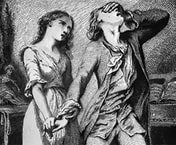 Werther, Cult of Sensibility Items of Interest:
Werther, Cult of Sensibility Items of Interest:I did wonder why I kept ploughing through the dismal third act, but I got an unexpected reward. I was not aware that one of Jane Austen’s pieces of juvenilia is a short tale called Frederic and Elfrida. It differs in plot from the novel (and of course it’s funny), but I believe that there’s a connection between this novel and Austen’s burlesque. I think we can add this novel to the list of titles that Austen read or knew about.
Austen's Frederic and Elfrida is thought to have been written when Austen was 11 years old, and it is posted online at the Republic of Pemberley. Or you can listen to Dr. Octavia Cox reading it here while reading along with the Austen's fair copy.
Other features:The author inserts a little editorial in praise of George III, the queen, and his family, and wishes that the dissipated aristocracy would imitate their family virtues.There is also a little editorial against reading bad novels but in favor of some good authors. I'll get back to that one day to compare it with Austen's editorial in Northanger Abbey.I think the author gave Ellison a bout of virulent smallpox before his marriage to Elfrida as a way of explaining why he and Elfrida have no children.Elfrida's coed education with two boys might be another progressive signal from the author, but on the other hand, it is presented as having a bad outcome.Like most noblemen in these novels, Lord S___ faces no legal consequences for attempted abduction and assault, although his character is damaged.The characters discuss the influential and best-selling novel The Sorrows of Young Werther, which Wilmot praises, but criticizes for its glamorization of suicide. Werther concerns a man in love with a girl engaged to someone else.This novel has no sub-plots to speak of, no gallery of kooky characters, no auxiliary couples except for some very minor mentions of Captain Venables and his wife. Hannah marries, then actually leaves her husband to stay loyal to the Overbury/Wilmot family and he dies alone. The narrator doesn't comment on the propriety of this. Previous post: A German melodrama
 In my Mansfield Trilogy, a variation on Mansfield Park, Lieutenant William Price falls in love with Julia Bertram, but in addition to the difference in their station in life, he resolves not to ask Julia to face the hardships and separations of being a naval officer's wife. She is pressured to marry elsewhere. I tell their story in the second volume of the trilogy, A Marriage of Attachment.
Read more about my books here.
In my Mansfield Trilogy, a variation on Mansfield Park, Lieutenant William Price falls in love with Julia Bertram, but in addition to the difference in their station in life, he resolves not to ask Julia to face the hardships and separations of being a naval officer's wife. She is pressured to marry elsewhere. I tell their story in the second volume of the trilogy, A Marriage of Attachment.
Read more about my books here.
Published on March 06, 2024 00:00
February 29, 2024
CMP#175 Ella, the deserving heroine
 As soon as I had dispatched this letter, I drew my sword, and was about to plunge it into my heart! An intense fever seized me at the instant, and prevented me from committing the rash deed! I fell motionless on the bed, and remained some moments in the grasp of death!
As soon as I had dispatched this letter, I drew my sword, and was about to plunge it into my heart! An intense fever seized me at the instant, and prevented me from committing the rash deed! I fell motionless on the bed, and remained some moments in the grasp of death! -- a sample of the prose! Of this book1 CMP#175 Deserving of a better novel, that is: Ella Rosenberg (1808), by William Herbert, Esq.
 I can't even I’ve read 100 novels of the long 18th century, and William Herbert’s Ella Rosenberg is a strong candidate for the worst. Thankfully it's short--only two volumes, and most of volume one is taken up with a separate tale which has nothing to do with the main plot. I wouldn’t even bother to write up a synopsis of this novel, except that I had promised to make note of any novel which featured a "fallen woman" who did not subsequently die, and—oops, that’s a plot spoiler. Anyway.
I can't even I’ve read 100 novels of the long 18th century, and William Herbert’s Ella Rosenberg is a strong candidate for the worst. Thankfully it's short--only two volumes, and most of volume one is taken up with a separate tale which has nothing to do with the main plot. I wouldn’t even bother to write up a synopsis of this novel, except that I had promised to make note of any novel which featured a "fallen woman" who did not subsequently die, and—oops, that’s a plot spoiler. Anyway.Ella Rosenberg is a semi-historical melodrama set amidst jealous and bickering German nobility. It’s a Romeo-and-Juliet tale about Harold, who rescues a girl from drowning when her carriage veers in to a canal. He promptly falls madly in love with her, and then he destroys her life. That is, he insists on pressing his suit, and will not listen to his father’s very good advice to establish his military career and grow up a bit, before he thinks about marrying. No, instead, Harold takes his dad’s money, goes AWOL, stalks Ella at her family’s country retreat, enrages her father, a powerful Baron, and pressures Ella to elope with him...
 Shelley-like behaviour Deluded Romeo
Shelley-like behaviour Deluded RomeoIs this a story about marrying for love instead of money? At first it appears so: the Baron “considered his daughter as an invaluable treasure, to be disposed of, like an article of merchandize, to the best bidder.” While Harold pleads and Ella agonizes, we have the lengthy interlude of the story of Julia and Hoffman, wherein a virtuous tenant farmer saves the lives of Julia and her noble mother and father, while her cowardly high-born fiancé runs away. Julia and Hoffman end up enjoying Love in a Cottage together.
By the way, Janeites will enjoy this tidbit, given to establish Ella's credentials as a lovely heroine: “her condescension made her idolized by a grateful tenantry, whose cottages she visited in person; and… when she entered the hovel of indigence or sickness... everywhere her footsteps left behind them the traces of pity and the balm of consolation.”
Ella eventually flees with Harold, after he threatens to kill himself, and it becomes immediately obvious that they haven’t thought things through. To be fair, the narrator says so as well, giving one of those "Take heed, young reader!" exhortations. Harold thought his uncle would take them in, but he refuses, because Ella's father is a powerful man. Ella now repents: “to you, have I sacrificed my peace and honor! My innocence and youth have this day been plunged into an abyss of shame, never to rise again! Complete your work—finish what you have began, and triumph over my virtue!"
Having no money (because Harold has managed to spend the 100 gold florins he took from his father) and no place to live, they do not consummate their relationship, and Harold wakes up in a rustic peasant's cottage to find Ella has left him to retire to a convent to atone for her filial disobedience.
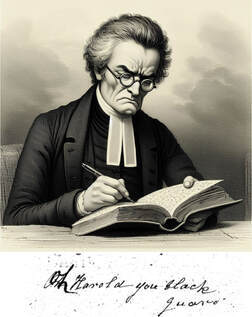 AI's conception of the anonymous commenter "Oh Harold, you blackguard"
AI's conception of the anonymous commenter "Oh Harold, you blackguard"Broken-hearted, Harold enlists in the army under an assumed name, and because he can’t make use of the fact that he’s actually the son of a Count, he is stuck without advancement for eight long years. By sheer chance, he finds Ella—Ella Rosenberg that is, because for some reason, Harold calls the woman he loves “Ella Rosenberg” through the entire novel--she is now a successful tragedienne, travelling about the country with a troupe of actors. And you know what that means, it means she’s a fallen woman, a painted doxy. Harold visits her in her dressing room and upbraids her for a few pages for being a strumpet and a floozy. “'O, Ella Rosenberg,' said I, 'you are, indeed, an object of pity! –-Into what an abyss do I see you plunged!—How could you thus, inconsiderately, overstep the boundary of virtue?... But, are you bound for ever to this disgraceful employment?—Is all lost—no hope left?—Is your heart—that heart which formerly was the abode of the most precious innocence, so corrupted, so sunken below its former state, that it cannot recover itself?'” And on and on in the same vein. It is at this point that an exasperated reader wrote: "Oh Harold, you blackguard" in the margin of the digitized copy of the novel I'm reading online.
Ella tearfully explains that no convent would admit her, and she was saved from utter destitution by a kindly lady who saw her by the side of the road and offered to pour the "balm of consolation" on her wounded spirit. She turned out to be not a panderer, as you might expect. "I soon found, with vexation, that her profession was that of a comedian." (Oh no!) So Ella went on the stage.
This is not good enough for our hero, who promptly attacks Ella’s lover when he comes to visit, and wouldn’t you know it, it’s his superior officer. That means he goes straight to a prison cell to await his execution.
 Enter the Abbott
Enter the AbbottWhen Harold is led to the scaffold, Ella dramatically rushes up and swallows some poison and dies. This makes the crowd insist that he be reprieved, so back to prison he goes, where he is visited by an abbot who had once been a member of his mother’s household. The abbot conducts him to a lonely prison cell in Horsa, because someone, somewhere, has commuted his sentence. We learn all this from a letter written from the prison cell by the “wretched Harold” himself. The sequel then commences, and everything that happens hereafter is because of the tireless efforts of that abbot who just dropped into the novel on page 152 of Volume 2. After six months in prison, the “benign abbot” informs Harold that he’s free to go. The abbot has also succeeded in melting the obdurate heart of Baron Rosenberg; he blames himself for his daughter’s suicide.
“O, I would give worlds to bring her back to life—to know she is not gone to prefer a filial curse against me at the bar of her heavenly parent!”
Dying repentant, Baron Rosenberg gives “the estate at Dorflein” to Harold with his last breath and asks to be buried there beside his daughter.
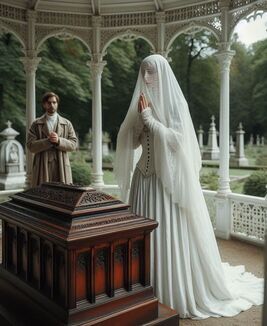 Fancy meeting you here: Bing AI image "Vicious" as in "vice"
Fancy meeting you here: Bing AI image "Vicious" as in "vice" There is a brief gothic flicker when Harold, visiting the tomb of his beloved, sees what he thinks is a beautiful statue. But hey, it’s Ella! Ella Rosenberg, to be precise! Not dead! She'd only had a "dreadful fit!" The abbot knew this all along!
No doubt her father would have liked to have known that before he died of grief and remorse over his daughter being buried in unconsecrated ground. On the other hand, the baron was also a murderer, a plot point which the author threw into a parenthetical mid-sentence interjection (see above left, an excerpt from the abbot's monologue).
Let’s skip to the unexpected happy ending: "Thus, sir, I finish my eventful history… grateful, with Ella Rosenberg, to an All-wise Providence, for his goodness, which often permits the feet of the best to slip, but will not suffer them finally to fall!"
So, Ella not only supported herself for eight years, but she is repentant and redeemed from her floozy lifestyle, and becomes a virtuous matron. Possibly the author was able to get away with no harsher punishment for Ella because the tale is set in a foreign country, at some indeterminate time in the past. Otherwise, the critics (if the critics had noticed this novel) would have condemned it, I think, for more than lousy writing. The author actually anticipates criticism on this point, because in a footnote, he writes: “It may be reproachfully urged against the author, that he has made his Ella Rosenberg partly a vicious character; while, on the contrary, all Novel writers depict only the Heroine: but he has rather endeavoured to paint the weakness of nature: and he submits to the Reader, whether experience be not on his side." "Heroine" in that sentence implies a "picture of perfection."
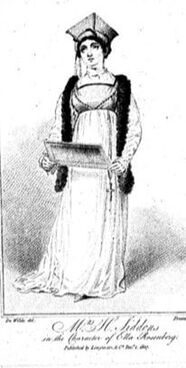 For reasons I can't explain, this novel was chosen by William Hazlitt in 1840 for inclusion in an anthology of novels, "The Best Works of the Best Authors." W. Herbert, Esq.'s name is likely a pseudonym. He also wrote The Spanish Outlaw (1807), also unreviewed.
For reasons I can't explain, this novel was chosen by William Hazlitt in 1840 for inclusion in an anthology of novels, "The Best Works of the Best Authors." W. Herbert, Esq.'s name is likely a pseudonym. He also wrote The Spanish Outlaw (1807), also unreviewed.Our current novel was “founded upon the famous [1807] melodrama of James Kenney, Ella Rosenberg,” according to pioneering scholar of gothic literature, Montague Summers. Well, except that it's very different. To be fair to Summers, he probably never got his hands on a copy of the novel back in 1941, in the pre-digital age.
Ella Rosenberg, the play, is a highly dramatic and emotional variation on King David and Bathsheba, in which a corrupt nobleman tries to destroy one of his officers so he can enjoy his beautiful wife. Virtue triumphs in the end, thanks to the local prince of whatever tinpot German principality the story is set in, and at Covent Garden the title role was played by no less than the great tragedienne Sarah Siddons. It’s such a pure melodrama that it’s rather fun to read. This novel, on the other hand, is funny for all the wrong reasons. But it's another example of how even young girls were expected to show agency in resisting the blandishments of their lovers.
I'm guessing the copycat name was done at the instruction of the publisher, JF Hughes, who was quite the unprincipled scamp. He published novels by "Mrs. Edgeworth" or "Caroline Burney" to trick people into thinking that the novel was by an Edgeworth or a Burney. He retitled a novel A Winter at Bath to imitate a rival publisher's A Winter in Bath. Perhaps the heroine originally had a different name like Friederike, and he said to the compositors: "replace the heroine's name with Ella Rosenberg" and they did the 18th-century version of "find and replace," and instead of "Ella" they always put in "Ella Rosenberg."
Previous post: Double feature: Margiana and Susan
Published on February 29, 2024 00:00
February 22, 2024
CMP#174 Margiana, a Heroine Austen Knew
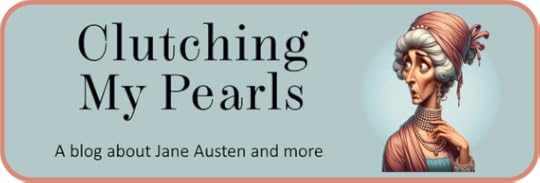 This blog explores social attitudes in Jane Austen's time, discusses her novels, reviews forgotten 18th century novels, and throws
some occasional shade
at the modern academy. The introductory post is here. My "six simple questions for academics" post is here. CMP#174 A Novel Jane Austen Read and Another Novel She Might Have Read
This blog explores social attitudes in Jane Austen's time, discusses her novels, reviews forgotten 18th century novels, and throws
some occasional shade
at the modern academy. The introductory post is here. My "six simple questions for academics" post is here. CMP#174 A Novel Jane Austen Read and Another Novel She Might Have Read
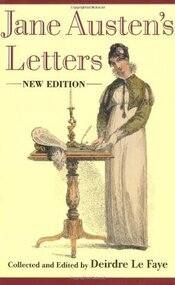 Jane was hopping mad at Crosby Well, lately we’ve
had novel
after novel which focusses on heroines guarding their chastity at all costs. There were some other implicit values for female behaviour and they feature in the following two novels, one of which Austen read, and another which she might have read. These strictures are: (1) never complain about your husband and (2) never, ever confess your love to a man before he's said he loves you.
Jane was hopping mad at Crosby Well, lately we’ve
had novel
after novel which focusses on heroines guarding their chastity at all costs. There were some other implicit values for female behaviour and they feature in the following two novels, one of which Austen read, and another which she might have read. These strictures are: (1) never complain about your husband and (2) never, ever confess your love to a man before he's said he loves you.Susan, a novel, (1809) author unknown, was published in 1809 by J. Booth. Scholars surmise that the appearance of this novel spurred Jane Austen to write the publisher Benjamin Crosby, who had purchased the manuscript of her novel Susan (the gothic spoof which was finally published as Northanger Abbey), to ask him, when was he going to publish her novel? He, or rather his son Richard, replied that they owned the manuscript, they were under no obligation to publish it, and she could have the rights back by refunding the ten pounds she'd received for the manuscript. The matter rested for a few years more until Henry Austen, Jane's brother, paid the ten pounds and then informed Crosby that the manuscript he had spurned was by the author of the well-received novels Sense and Sensibility and Pride and Prejudice.
So we might expect that Jane Austen at least looked at the novel Susan. She also changed the name of her heroine from Susan to Catherine.
But first, let's look at a novel which we're pretty sure Austen read, because she joked about it in another one of her letters: Margiana, or Widdrington Tower (1808), by Mrs. Sykes.
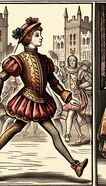 Cross-dressing third heroine Keep a tight control on your heart
Cross-dressing third heroine Keep a tight control on your heartMargiana is a historical gothic romance, set in the 14th century at the outset of the Wars of the Roses. Margiana is beautiful and intelligent. Her younger sister Genevieve is also a beauty, but not as bright and resolute as Margiana. These medieval maidens live by the same rule of conduct which Juliet references when Romeo overhears her declaring her love for him: "Fain would I dwell on form. Fain, fain deny what I have spoke!" Austen also alludes to it in Northanger Abbey: "no young lady can be justified in falling in love before the gentleman’s love is declared."
Margiana's sister Genevieve falls for their cousin Ethelred, but seeks to save her pride by remembering her sister's maxim: "that a woman ought never to put her affections out of her own power, unless she is certain of their being returned, as well as properly placed."
Ethelred rebukes a designing young villainess for making a pass at him: “when a lady obtrudes her affection in a quarter from whence none has ever been offered to her, she excites a sentiment more unlike to love than even hatred itself—contempt.”
 Bing AI generated image Never complain, always forebear
Bing AI generated image Never complain, always forebearMargiana’s mother, Lady Widdrington, just like Lady Kenheath in our next novel Susan, loves her husband but nurses a lifelong wounded heart because he doesn’t love her back. Both husbands are disappointed that their wives haven’t presented them with a son. Both husbands had a first love and they married out of convenience, not love.
I’m not saying one novel is copied from another, I am saying that these are common tropes and situations which are recycled and used again and again in novels of this era.
Both this author and the anonymous author of Susan approve of women who put up with neglect and coldness without complaint. “Yet at no time, and to no person, was [Lady Widdrington] ever heard to complain.” She dies, still suffering. While Margiana is filled with filial piety for her father, she also sees he’s a bad husband; the lesson she draws is to be very careful about who you marry--in fact she is leery of getting married at all.
She will get married, but first we've got five volumes to get through, with battles and sieges and castles and prisoners and villains (something Austen joked about) and misunderstandings and hauntings, and surprises and secrets revealed in the final chapters around parentage. Jane Austen joked about travelling to Widdrington and getting locked up in a tower, something that happens to more than one character. I got annoyed with the hero Ethelred when he believed something derogatory to Genevieve’s virtue and would not back down. When she tells him to his face that she did not send him a certain letter, he contradicts her. The novel also features a sprightly, cross-dressing third heroine named Arlette who travels around in male garb.
One last point: This story is set back when everyone was a Catholic, so the authoress assures her readers that her heroine is not only beautiful, but discerning: “the serious principles Margiana had imbibed from her [mother] were those, not of bigotry, but of pure and true religion, unalloyed with the blind superstition of the times." Note, by the way, the word "serious" used as an allusion to religious principles. Austen also used the word this way, as explained by Brenda S. Cox in her book, Fashionable Goodness.
A fuller synopsis of Margiana is available in The Gothic Novel 1790-1830 by Ann B. Tracy.
Now, to the two-volume novel Susan...
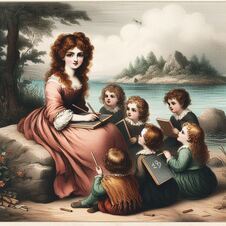 Susan volunteers to teach the local children. Bing AI-generated image. Susan is Sweet Sixteen
Susan volunteers to teach the local children. Bing AI-generated image. Susan is Sweet Sixteen The parentage of our titular heroine is ambiguous. Someone pays for her to be reared in innocence and solitude on an island in a remote part of Scotland. Susan is fortunate in her kind and judicious guardian/governess, Mrs. Howard, an army officer’s widow. The house is rented from a Scottish laird, Lord Kenheath. Susan meets him one day when he arrives on the little ferryboat that brings mail and supplies from the mainland. She jumps up like a frightened roe, as a good maiden should, and makes to run away. She slips and nearly falls into the water; he catches her hand and saves her. He admires her extremely, and right away we feel the uneasy vibes.
Kenheath insists on taking her to Edinburgh to stay with him and his wife. This makes Mrs. Howard uneasy, given that Lord Kenheath is a good deal older and Susan is inexperienced in the ways of the world. But she receives a letter affirming that it’s all right with Susan’s mysterious father, whoever he is.
On the way there, the travelers are involved in a carriage accident, one of several which the author resorts to in the story. Her other means of keeping her characters in one place, or keeping them out of the way, is to strike them with illness. Austen gets the Grants out of her way in Mansfield Park by giving Mr. Grant gout, but think about how subtly she does it, compared to (ahem) some other authors. At any rate, in the course of this first accident, Susan is thrown together with Lord Kenheath’s orphaned nephew, Archibald Hamilton, and the two promptly fall in love.
Another relative, Mr. Stuart, also likes the new houseguest. Getting her alone, he asks her if she’d like to become his mistress. This kind of insult always brings out the feisty in our heroines: “The purity of her own bosom had, for some time, prevented her understanding the nature of his proposals; but she was no sooner convinced of their unvarnished meaning, than all the indignant pride of virtue took possession of her soul. In a very few words she expressed her abhorrence and contempt of both himself and his infamous offers, and immediately rushed from his presence.”
Just as in Charlotte Summers, Lord Kenheath advises Susan to not make a scene, that it is better for her reputation if the whole thing is hushed up. So what’s up with this Lord Kenheath? His wife is rather uneasy about his designs on the girl.
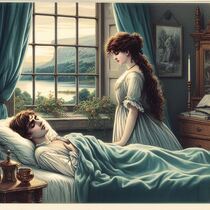 Bing AI-generated image Spoilers ahoy
Bing AI-generated image Spoilers ahoyAfter recovering from a serious fever, brought on by shock, Susan just wants to get back to her island, convinced that she won’t be able to marry Archibald since Lady Kenheath wants him to marry her daughter instead. A convenient carriage accident en route to her home brings her to the door of the MacLaurins, an ancient and numerous Scottish family who are gobsmacked by Susan’s resemblance to their long-lost beloved sister/daughter Mary, who eloped with some unknown man years ago.
Susan makes it back to her island, whither she is followed by young Donald MacLaurin, who has also fallen in love with her. A few days later, Archibald appears, to tell Susan that her beloved guardian Mrs. Howard is very ill with a fever, which is why she can't be there on the island during what follows. Archibald encounters Donald, high words ensue, and the two young men fight a duel on the front lawn. Archibald is the more severely wounded, and the only place for him to be treated and nursed is in Susan’s house.
The doctor says Archibald isn’t dying from his dueling wound, he’s dying from a broken heart, but even so, Susan won’t confess her love for him, because that would be immodest. A garrulous house guest, Mrs. Jane MacLaurin, bustles in to assure him that Susan doesn’t love Donald. Susan’s first thought is “Good heavens, Madam! He will certainly think I desired you to say all this. What an opinion must he entertain of me!” But as she thinks it over, she realizes it must be for the best that he learns that she loves him. It might save his life, after all.
The author still spares Susan from making a direct confession of her love. Once she has recovered enough from her own latest bout of fever and fainting fits (brought on by witnessing the duel), she sneaks into Archibald’s bedroom, thinking he is asleep, and sighs that she would willingly die for him. That’s good enough for Archibald, and he recovers.
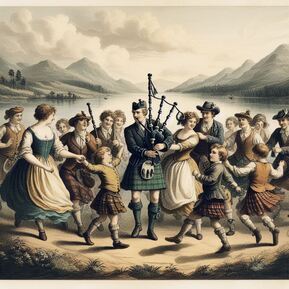 Secrets Revealed
Secrets RevealedLord Kenheath comes to the island and confesses that yes, Susan is his daughter, born of a secret earlier marriage. His deserted bride died of childbirth and shock after reading in the newspaper that he was engaged to marry an heiress. She died on the very day of his wedding—which is important, because that spares him from being a bigamist and his second daughter from being illegitimate. Lord Kenheath’s behaviour as a youth was absolutely deplorable and he’s still a world-class jerk to his current wife, whose behaviour has been irreproachable. Lord Kenheath is the reason Susan grew up on an island without knowing any family. He's the reason the MacLaurins mourned their beloved, vanished, Mary for years. He's the reason we, the reader, had to experience the good ol' incest tease with both him and Uncle Stuart. So of course our heroine falls to her knees and asks him for his blessing because he’s her father! And she asks the MacLaurins to forgive him for eloping with and then abandoning their beloved Mary. Because that’s how heroines do.
At least both sides of the family now agree that Susan and Archibald should get married, and since they are the legatees of Mr. Stuart, who conveniently died of a fever after a horse-riding accident, they have the means to do so. Cue the bagpipes and the happy peasants dancing on the greensward.
The only resemblance to Northanger Abbey that I can see is surely a coincidental one: After meeting Archibald Hamilton, Susan retires to her bedchamber to dream of him. Northanger Abbey has no fainting fits, no high fevers, no duels, and Catherine Morland knows who her parents are.
Of Susan, the reviewer for the Monthly Review remarked: “The language is always modest, though sometimes ungrammatical; and the tale contains a prodigious number of fevers, together with several faintings, two duels, [I only caught one] and one or two deaths.”
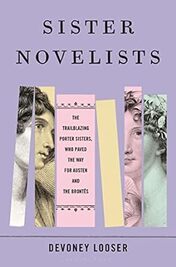 Margiana, or Widdrington Tower, did not receive any reviews when it was published. In fact, it seems none of the three novels Henrietta Masterman Sykes (1766-1823) wrote received reviews, but she has received some critical attention more recently. Her contemporary novel Sir William Dorien (1812) has been called Dickensian. I would say that her prose style is relatively free from trite cliches, she keeps her poetry-writing urges to a minimum, and she is not afraid of taking on complex plots connected to historical events. In this historical novel she refrains from having her characters speak forsoothly.
Margiana, or Widdrington Tower, did not receive any reviews when it was published. In fact, it seems none of the three novels Henrietta Masterman Sykes (1766-1823) wrote received reviews, but she has received some critical attention more recently. Her contemporary novel Sir William Dorien (1812) has been called Dickensian. I would say that her prose style is relatively free from trite cliches, she keeps her poetry-writing urges to a minimum, and she is not afraid of taking on complex plots connected to historical events. In this historical novel she refrains from having her characters speak forsoothly.Jane Austen was a partisan of the Yorks in the Wars of the Roses, or at least she was as a teenager, as revealed in her juvenile composition, The History of England.
I haven't read much of historical fiction from this pre-Walter Scott era, but two of the best-selling authors in this genre were the Porter sisters. Jane Austen scholar Devoney Looser has deeply researched and written a joint biography of Jane and Anna Maria Porter, who wrote innovative titles in this genre. Looser's book, Sister Novelists is a detailed portrayal of a fascinating family and a vibrant age.
I wrote earlier about the forbearing wife here.
Previous post: The first First Impressions
Published on February 22, 2024 00:00
February 15, 2024
CMP#173 The first First Impressions
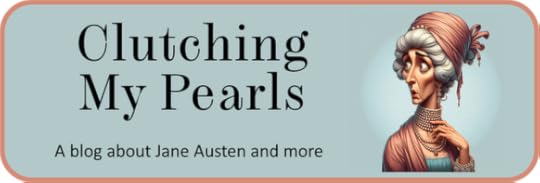 Marie de Vaublanc had just attained the age of seventeen, till which period sorrow had never obtruded itself on her youthful mind; she knew not, and therefore did not fear, the unsteadiness of Fortune. Alas! To the eye, accustomed only to a continued sunshine, how fearful must be a lowering sky!... --opening of First Impressions CMP#173 Book Review: First Impressions, or, the Portrait (1801)
Marie de Vaublanc had just attained the age of seventeen, till which period sorrow had never obtruded itself on her youthful mind; she knew not, and therefore did not fear, the unsteadiness of Fortune. Alas! To the eye, accustomed only to a continued sunshine, how fearful must be a lowering sky!... --opening of First Impressions CMP#173 Book Review: First Impressions, or, the Portrait (1801)
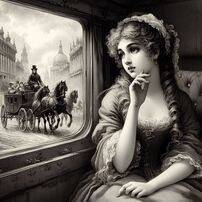 Hapless heroine thrown upon the world. AI generated image. My latest article in
Jane Austen's Regency World
magazine (Jan/Feb 2024 issue) concerns the novel First Impressions by Margaret Holford. As devoted Janeites know, First Impressions was Austen's original title for Pride and Prejudice, and it's generally thought she changed the title because Holford's novel came out first, in 1801. Perhaps, having heard of the novel, Austen got her hands on a copy, to see how it compared with her own unpublished work. I think there are indications in Pride and Prejudice that Austen indeed read and drew some inspiration from First Impressions. For that matter, astute Janeites will spot a slight similarity between the opening of the novel, which I quoted above, and the opening of another Austen novel. But I won't take that up in this post. Instead, here's a plot synopsis. You'll see that this novel continues our theme of girls who must fight to preserve their virtue. The titillation of the tale arises from the perils to which Maria is exposed, and the moral lessons arise from the lengths to which our heroine will go to preserve her virgin honour.
Hapless heroine thrown upon the world. AI generated image. My latest article in
Jane Austen's Regency World
magazine (Jan/Feb 2024 issue) concerns the novel First Impressions by Margaret Holford. As devoted Janeites know, First Impressions was Austen's original title for Pride and Prejudice, and it's generally thought she changed the title because Holford's novel came out first, in 1801. Perhaps, having heard of the novel, Austen got her hands on a copy, to see how it compared with her own unpublished work. I think there are indications in Pride and Prejudice that Austen indeed read and drew some inspiration from First Impressions. For that matter, astute Janeites will spot a slight similarity between the opening of the novel, which I quoted above, and the opening of another Austen novel. But I won't take that up in this post. Instead, here's a plot synopsis. You'll see that this novel continues our theme of girls who must fight to preserve their virtue. The titillation of the tale arises from the perils to which Maria is exposed, and the moral lessons arise from the lengths to which our heroine will go to preserve her virgin honour. Holford's First Impressions is a four volume novel, and although the action drags a bit in the middle as we suffer along with the heroine through her various vicissitudes, I have to say it starts out with a bang--Holford wastes no time in setting up her heroine to be both penniless and friendless. Her plight is not a very good reflection on the foresight of her late guardian, Madame de Vaublanc, when it comes to estate planning. We have to assume that good old lady didn’t realize her cousin and executor was dishonest and corrupt, although the fact that his name is “Gripe” should have tipped off any cautious woman...
 Harassed wherever she goes: The Irritating Gentleman, Woltze Who's up for a reformed rake story?
Harassed wherever she goes: The Irritating Gentleman, Woltze Who's up for a reformed rake story?It is “brutally revealed” to Marie by this lawyer/cousin that she is not a de Vaublanc. They rename her "Maria Clive." No-one knows who her parents are, and the Gripes are not obliged to help her. Mrs. Gripe gives Sense and Sensibility's Fanny Dashwood a run for her money--Marie will be permitted to keep only the clothes on her back.
Maria is told she's been given a job as a governess. She is packed off to a distant English country house but when she arrives there, after travelling unescorted by mail coach, she discovers it’s the home of Sir Edwin, a roguish baronet. The woman from the employment agency was actually a panderer, and Maria—an extremely beautiful girl—has been sent there for the rake's approval.
Luckily for Maria, Sir Edwin is away from home, which gives her time to win over the old housekeeper and convince her that she is not a shameless floozy but a genuine virginal innocent. The neighborhood, however, assumes differently—otherwise why would she be there? No smoke without fire, you know. In addition, Maria's unknown parentage means she might be illegitimate. This, plus her poverty, make her ineligible for a good marriage and highly eligible to be propositioned wherever she goes. Remember how Mr. Knightley in Emma talks about how Harriet Smith will be "retired enough for safety... never led into temptation, nor left for it to find her out." That's what he's talking about.
When Sir Edwin does come home, he is enchanted with Maria and offers her a fortune if she'll be his mistress. She eloquently and vigorously refuses--he is surprised at her, and ashamed of himself. We learn that Sir Edwin, in an act of careless bravado, recently vowed he would marry the first truly chaste and virtuous woman he met, since he believed no such woman could exist. But here she is, a transcendently beautiful girl warbling a Rossini aria at an ivy-covered window. Maria’s vocabulary and formal way of speaking makes it clear that she is genteel, intelligent and well-educated, and whatever her current position in life, she came from better things.
 Northanger Abbey's John Thorpe The Perils of a "Picture of Perfection" Heroine
Northanger Abbey's John Thorpe The Perils of a "Picture of Perfection" HeroineSir Edwin sends Maria to live with his married sister Mrs. Brudenell to acquire some more social polish, without telling Maria he plans to marry her. He goes abroad to Europe in the meanwhile, and the hero and heroine are separated and out of communication with each other for most of the book.
From here, most of the plot is taken up with the perils of being so beautiful that you can't step outside without being accosted or propositioned. For example, while Maria is walking quietly in her mourning clothes, a young man lazily strolls by and “one glance from her bright eyes roused him from his lethargy, like an electrical shock, and extorted from him two whole ejaculations, and half as many interrogatories.”
Mrs. Brudenell--deceitful, cruel, and sarcastic--is the most interesting and vivid character in the book. She’s horrified that her brother is thinking of marrying some unknown chit on a crazy whim, and she plots to get Maria married off to somebody else before her brother returns. She lights on a family relation, Samuel Dibbins, an oafish John Thorpe type, and even arranges for Samuel to take Maria for a day trip to see some ruins with the real intent of carrying her off to Gretna Green, but the plan fails.
To Mrs. Brudenell’s disgust, the most eligible bachelor in the neighborhood also falls for Maria. But Maria won’t have him either, for she won’t give her hand without her heart. Maria (alas!) is carrying a torch for Sir Edwin, even though she knows he’s a rake.
To make matters worse, Maria learns that Mr. Brudenell is plotting to have his wicked way with her. First, he tried the old Godwinian free love arguments on her: “Yet, with a mind enlightened, and soaring above the common race of mankind, can I suppose you shackled by the false prejudices of Churchmen and fanatics"? Since that failed, he will surely resort to force. She flees in the dead of night.
 Image courtesy of Bruce Peel Special Collections, University of Alberta Accident-prone heroine
Image courtesy of Bruce Peel Special Collections, University of Alberta Accident-prone heroine Volume III brings another series of adventures: Maria helps a wounded woman lying in the road, then is falsely accused of theft. That's followed by an attempted abduction and a carriage accident. She is briefly taken in by a genteel family and she engages in some private theatricals, where, coincidentally, she bumps into Sir Edwin again. She flees.
Suffice it to say that no matter what she does, Maria can’t catch a break. Although she is now wan and pale and thin, her beauty is still so amazing that she must continue to fob off insulting propositions. Reduced to working as a milliner’s assistant, she begs to excused from waiting on the customers, and who can blame her?
But worse luck, she's asked to deliver a parcel and she runs into some old enemies... Through a series of coincidences, our hero, now convinced of her worthiness to be his bride, follows her trail, finds her, and proposes marriage. Happy ending? No! Because of the extraordinary rectitude of her principles, our heroine goes from fleeing from Sir Edwin because he’s of a “dissipated character,” to fleeing from him because she’s not worthy of a man who has recently been elevated from baronet to Earl. We've another volume to go... which includes being wrongfully fired from her job, another carriage accident, and a house fire. None of this will make her relent. It takes some more misadventures and an overheard conversation (see frontispiece picture above) in which she betrays her affection for Sir Edwin before he can lead her to the altar.
After the ceremony, but before they even cut the bride cake, a long-lost relative shows up with the amazing revelation of our heroine’s true noble and legitimate parentage. She is worthy of being a Countess! And she will live happily ever after. The heroine has proved she has married Sir Edwin for disinterested motives, and he has proved that he loves her for herself, not because of her family tree.
 Miss Dashwood takes great interest in Maria. (Lady's Magazine fashion print, National Portrait Gallery) Other points of interestMrs. Brudenell gets sarcastic with Maria when she is at her most butter-wouldn't-melt-in-her-mouth heroine-like. It seems like a way of having your virtuous heroine and making fun of the tropes at the same time. The author can wink at the audience or express her own impatience with the picture of perfection heroine. I also noticed this in
the novel Clarentine.
Touches of feminism: Maria has dignity and stands up for herself; it just happens to be in the context of never-ending threats to her virgin purity, but there is still something proto-feminist in the way she sets a value upon herself. She cries, with good reason, but hardly ever faints. Before her marriage, she remarks to her fiancé: “it will so soon to become my duty to consider your Lordship’s entreaties as commands, that it may be well, perhaps, to make a merit of obedience while I can.” “As for commands and obedience,” said he, “I abjure the words. No, no, pride and delight of my heart! where love is mutual, mutual also must be the wish to please.”Holford includes
an Amazon character,
Miss Dashwood, who lives for the hunt but who also takes (ahem) quite an interest in our heroine. Nothing comes of it, however and by the end of the novel Miss Dashwood and other secondary characters are all paired off and married.The author does a good job of linking her large cast of characters together and resolving all the plotlines. Most of her characters have some role to play in the plot, and are not just there to serve as warnings or comic stereotypes. Margaret Holford (1778–1852) and her mother, also Margaret Holford (1757–1834), were authors, poets, and playwrights. The Orlando database of women writers says that First Impressions was written by Holford the elder.
Miss Dashwood takes great interest in Maria. (Lady's Magazine fashion print, National Portrait Gallery) Other points of interestMrs. Brudenell gets sarcastic with Maria when she is at her most butter-wouldn't-melt-in-her-mouth heroine-like. It seems like a way of having your virtuous heroine and making fun of the tropes at the same time. The author can wink at the audience or express her own impatience with the picture of perfection heroine. I also noticed this in
the novel Clarentine.
Touches of feminism: Maria has dignity and stands up for herself; it just happens to be in the context of never-ending threats to her virgin purity, but there is still something proto-feminist in the way she sets a value upon herself. She cries, with good reason, but hardly ever faints. Before her marriage, she remarks to her fiancé: “it will so soon to become my duty to consider your Lordship’s entreaties as commands, that it may be well, perhaps, to make a merit of obedience while I can.” “As for commands and obedience,” said he, “I abjure the words. No, no, pride and delight of my heart! where love is mutual, mutual also must be the wish to please.”Holford includes
an Amazon character,
Miss Dashwood, who lives for the hunt but who also takes (ahem) quite an interest in our heroine. Nothing comes of it, however and by the end of the novel Miss Dashwood and other secondary characters are all paired off and married.The author does a good job of linking her large cast of characters together and resolving all the plotlines. Most of her characters have some role to play in the plot, and are not just there to serve as warnings or comic stereotypes. Margaret Holford (1778–1852) and her mother, also Margaret Holford (1757–1834), were authors, poets, and playwrights. The Orlando database of women writers says that First Impressions was written by Holford the elder. More about the emphasis on female chastity here. And if you want even more, there's this novel and this novel and this novel.. I've found two reviews for First Impressions. The Critical Review said "there is nothing reprehensible in First Impressions except its bulk. The author tells Miss Seward , in a dedication, that she will not find anything in it injurious to religion or morality. We are happy to confirm this her declaration to the public; and if she had prevailed on that lady to compress the work into half its present size, by retrenching its superfluous garrulity, every incident might still have been narrated, and the reader would have found it not an unpleasing performance." The Anti-Jacobin Review was more favourable: “The hair-breadth ‘scapes of the heroine in this story are well imagined and naturally described. The characters are judiciously varied, and very ably hit off. It is on the whole an agreeable amusement, inculcating good morals, and devoid of those false but specious sentiments of the new Philosophy which only allure to betray." The novel was dedicated to Anna Seward, a successful poetess who never married and who had intense relationships with women. If there are indeed lesbian undertones with the character of Miss Dashwood, it either escaped the notice of the reviewer or else did not offend him. First Impressions was published by the Minerva Press, which as we've learned, was not a high-brow publishing house. I suspect Mrs. Holford wrote the lengthy novel to conform to the instructions of her publisher, who was in the business of giving the reading public what they wanted to read.Austen family history says Austen wrote her draft of First Impressions, possibly in epistolary form, in 1796-97. Her father, perhaps a bit naïve in the ways of book publishing, sent a letter offering the novel to the most prestigious publisher in London, who refused the manuscript sight unseen. History doesn’t record if Austen or her family made any other efforts to get the book published, and it did not come out until 1813, as Pride and Prejudice.
Previous post: Charlotte, the uber heroine
Published on February 15, 2024 00:00
February 8, 2024
CMP#172 Charlotte, the original heroine
 This blog explores social attitudes in Jane Austen's time, discusses her novels, reviews forgotten 18th century novels, and throws
some occasional shade
at the modern academy. The introductory post is here. My "six simple questions for academics" post is here. CMP#172 The History of Charlotte Summers, the Fortunate Parish Girl (1749)
This blog explores social attitudes in Jane Austen's time, discusses her novels, reviews forgotten 18th century novels, and throws
some occasional shade
at the modern academy. The introductory post is here. My "six simple questions for academics" post is here. CMP#172 The History of Charlotte Summers, the Fortunate Parish Girl (1749)
 Charlotte Summers frontispiece, detail I read somewhere (but can’t track down the quote) that Charlotte Summers is an uber novel of its type: go through the plot of Charlotte Summers and you can find the themes and tropes \-which preoccupied British literature for the next century.Friendless, orphaned girl is thrown upon an uncaring world. Her backstory involves a lot of bad luck and death.She is beautiful, accomplished, devout, and virtuous.She fends off unwanted male attention, up to and including assault.She is pressured to accept an unwanted suitor, or is accused of trying to ensnare a man.She turns down a marriage proposal from a suitor who is much beneath her in education, intelligence, or social standing. Despite her perilous or lowly condition, she refuses to marry for money, or give her hand without her heart.Other women are jealous and behave spitefully towards her.She gets into trouble with the law although she is completely innocent.She has to move from place to place when her situation becomes untenable.A happy coincidental reunion restores her to her family or to her familial rights.She marries the man she loves. Charlotte Summers may be the fortunate parish girl but her good fortune is very much checkered, as she checks all the boxes above. And even though I've just told you the plot of the book (and the plots of many other books), I'll give you a synopsis anyway. There are also some interesting questions of style, language and message to consider...
Charlotte Summers frontispiece, detail I read somewhere (but can’t track down the quote) that Charlotte Summers is an uber novel of its type: go through the plot of Charlotte Summers and you can find the themes and tropes \-which preoccupied British literature for the next century.Friendless, orphaned girl is thrown upon an uncaring world. Her backstory involves a lot of bad luck and death.She is beautiful, accomplished, devout, and virtuous.She fends off unwanted male attention, up to and including assault.She is pressured to accept an unwanted suitor, or is accused of trying to ensnare a man.She turns down a marriage proposal from a suitor who is much beneath her in education, intelligence, or social standing. Despite her perilous or lowly condition, she refuses to marry for money, or give her hand without her heart.Other women are jealous and behave spitefully towards her.She gets into trouble with the law although she is completely innocent.She has to move from place to place when her situation becomes untenable.A happy coincidental reunion restores her to her family or to her familial rights.She marries the man she loves. Charlotte Summers may be the fortunate parish girl but her good fortune is very much checkered, as she checks all the boxes above. And even though I've just told you the plot of the book (and the plots of many other books), I'll give you a synopsis anyway. There are also some interesting questions of style, language and message to consider...
 Our story begins:
Our story begins:Lady Bountiful is out walking when she sees a beautiful child with golden curls wearing the rough, plain uniform of a child living on parish relief. She talks to the child and becomes convinced that she must be from a good family and has unaccountably ended up in this dire situation. The author gives us a Dickensian or Hogarthian picture of the neglect and abuse suffered by children “on the parish.” It’s clear that Charlotte might not survive her childhood if she remains where she is, so Lady Bountiful impulsively takes her home and semi-adopts her. This, despite the fact that Lady B has a kind-hearted, handsome young son. Sir Thomas (who has inherited his late father’s baronetcy) is about the same age as Charlotte.
Charlotte is suitably grateful, and she takes advantage of the good education she receives. We have an early precursor of Mansfield Park, in that for a time a member of the household, Mrs. Eggleston, despises Charlotte and is miserable to her, Aunt Norris-style. Mrs. Eggleston convinces the gullible Lady B that Charlotte is a sneak thief, and Lady B casts the weeping little girl out of the household. Lady B’s clergyman gives her refuge until the "stolen" items are discovered in Mrs. Eggleston’s cupboard, then Charlotte is recalled, to the joy of Sir Thomas, who calls her “his little wife.”
Charlotte is such a saintly child that she pleads for pardon for Mrs. Eggleston: “I hope,” says she, “Lady Bountiful has not turned her out of the House, I should be very sorry for her; for though she hated me, yet I never wished her any Harm, and I could fall down on my Knees to beg Lady Bountiful to forgive her.” But the “malicious, designing Termagant” is banished and disappears from the story. She lives on, however, in the character of Aunt Norris, and in children's literature as Miss Minchin in A Little Princess (1902) and Miss Slighcarp in The Wolves of Willoughby Chase (1962).
 Image created with Bing AI Charlotte’s mother’s backstory
Image created with Bing AI Charlotte’s mother’s backstorySomething fortunate occurs: Charlotte’s mother’s faithful servant comes back from an extended visit to her family and tracks Charlotte down. We learn Charlotte’s most unfortunate backstory through Margery’s garrulous narration. Charlotte’s mother was orphaned as a young woman and married a fortune hunter (Irish, I need hardly say), who blew through her inheritance. She was reduced to painting fans to support herself and living in cheap lodgings. The faithful Margery learns that her absentee husband was lying ill in another part of town because he's caught the clap from one of his doxies.
The loyal wife pawns two of her remaining nice gowns to raise money and rushes off to see him. She puts up with everything and only protests when she learns that he plans to disavow their marriage so he can marry another girl to get his hands on another dowry.
“Ah cruel Man,” cried she, “is it not enough that you have squandered away my Infant’s substance... must you add Infamy to Want, proclaim me a Prostitute and the little Innocent a Bastard; Oh my God how shall I endure it... I could die to make him easy, renounce all Claim to his Person, but I cannot live with Infamy, or suffer my Child, the first dear Pledge of our mutual Happiness, to be stained with Bastardy.”
After literally showing up with the bailiffs to take away all the remaining furniture to sell, Charlotte’s father disappears from the scene. Her mother declines and dies, and that’s how Charlotte ended up on parish relief.
 Image created by Bing AI Charlotte as a young woman Content warning
Image created by Bing AI Charlotte as a young woman Content warningOnce Charlotte is in her mid-teens, she is an absolutely gorgeous little bundle who attract the attentions of a houseguest, Mr. Crofts. The author’s description of his attempt to have his way with her is more explicit and ribald than the decorous off-stage doings in Austen: “The Moon shone bright through two large Holes in the Shutters of each Window, neither the Curtains of the Bed, nor Window-Curtains being drawn, as it was in the Heat of Summer, and the Weather extremely hot, so that the enamour’d Crofts had a full view of his Prey, as she lay with her Face towards the Bed-side, her Head reclining upon one Hand, her Bosom bare, and the Cloaths almost down to her Middle. The Enchanting Beauties of what he saw, were sufficient to have kindled Desire in an Anchorite…”
Luckily, Charlotte wakes up, screams and summons help.
Lady Bountiful feels that the best thing to do in this situation is hush the whole matter up, because even though Charlotte escaped ravishment, if word gets out, her reputation is ruined anyway. She allows Mr. Crofts to continue as her houseguest. Mr. Crofts, repentant, says he will marry Charlotte and Lady B urges our heroine to marry her attacker. Charlotte pleads that her “Benefactress, whose pious Care has redeem’d me from Wretchedness,[and] has instilled into me a Notion of Virtue and the Honour of my Sex, will not now insist upon making me miserable with the Man I loath.” “No, replied Lady Bountiful, embracing her kindly, “I don’t intend to force your Inclination; I love that Pride which, if not carried into Extremes, is the Ornament as well as Safeguard of our Sex; but if the Idea of that rash action is so much at present, my Dear, in your Memory, you carry your Resentment too far. Time and the Gentleman’s respectful Behaviour will wear it off…”
It is ghastly to think that this kind of thinking is still extant in some cultures. Charlotte even calls the offer “legal prostitution.”
When Sir Thomas returns from a hunting party and hears what has happened, he attacks Mr. Crofts. Due to a servant's erroneous report, Charlotte thinks Mr. Crofts has murdered Mr. Goodheart, the household steward. “[T]he Horror and Surprize was too quick for her Spirits; she fell into a deep Swoon, after uttering, in a very melancholy Tone, --Alas, the good Man has got his death for my sake --She continued out of one Fit into another for near two Hours, and when able to breathe, was in a high and delirious Fever.” Too late, the impetuous Sir Thomas comes to realize that his very public actions have brought notoriety on the girl he loves.
When Charlotte recovers her health, she does not regain her peace of mind. Lady B blames her for trying to angle for Sir Thomas, when the truth is Charlotte absolutely refuses to marry him, because it would be an act of ingratitude toward Lady B. Charlotte knows Lady B has no intention of marrying her, a nobody, to her baronet son. Sir Thomas is miserable, and when a servant mistakenly thinks, and hints to Charlotte, that Sir Thomas is planning to visit her bedroom to force his attentions on her, she flees the house.
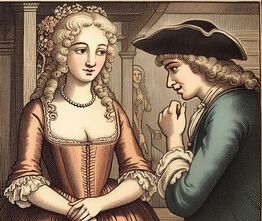 Image created by Bing AI Hideout at the farmhouse
Image created by Bing AI Hideout at the farmhouseCharlotte intends to make her way to London (for at least she as a little money and some valuables) and find a job. She is waylaid by robbers but rescued from assault and robbery by a kindly farmer who takes her home to wait for the next weekly stage. She is grateful for her escape, even though the farmer and his family are clodpoles. In no time, trouble rears its ugly head when an oafish neighbour, plus the oafish farmer’s son, both propose marriage to her: “When shall we send to the Clerk to proclaim the Banns,” exclaims one; “do let it be in a short Time, for I’m a woundy Hurry, till you and I get between a Pair of Sheets: Odds-bodikins!”
She proudly refuses the offers. Out of resentment, and with an eye on her money and valuables, the farmer’s wife and her sister falsely accuse Charlotte of being a thief. How else could she have come by ten golden guineas? She is hauled off to a magistrate, Mr. Easy, who swiftly decides in her favour and Mrs. Easy takes Charlotte under her wing.
Meanwhile, Sir Thomas is searching for her everywhere. Here actually, we have a reverse of the common situation where the hero is falsely led to doubt the purity of the heroine: Sir Thomas is in anguish that “the lovely Maid must abhor me” because “she has gone with the damn’d Impression that I am a villain, a base Ravisher, and an Enemy to her spotless Innocence.”
Charlotte still wants to go to London and find a job, so Mrs. Easy sends her off to a friend in London with a recommendation for work as a lady’s maid. Through no fault of Charlotte’s, this position falls through and she’s friendless and alone in London, where it seems every landlady she turns to is a bawd in disguise who wants to sell her to the highest bidder. Her false friends rob her and trick her into becoming indebted to them for rent, then throw her in debtor’s prison. But Charlotte asks the bailiff’s wife to supply her with sewing materials and she sets about earning a living by embroidering aprons.
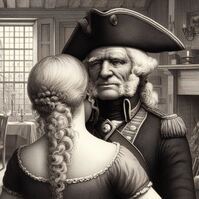 Image created by Bing AI The wheel of fortune turns:
Image created by Bing AI The wheel of fortune turns:Charlotte is at her lowest ebb when she is rescued by kind people who hear of her travails, get her stolen money back, and find her a home with a nice, respectable woman, Mrs. Morgan. Two years pass. And…
Guess who shows up, fabulously rich, and very repentant, after a stint in the East Indies under an assumed name? It’s dad! Captain Ainsworth, actually Captain Summers! Father and daughter are reunited.
The author announces, “After conducting my fair Parish Girl through various Distresses and Dangers, I have at last landed her safe at her Father’s House to the Enjoyment of the utmost Prosperity and Grandeur,” then he acknowledges the convention of the convenient Death: "it is Time to provide her with a Husband, and as my other Heroine the Lady Bountiful is grown pretty old and stands much in my way, it is full Time to think of sending her to her Grave, at least I am sure [her son] Sir Thomas thinks so… [but] these things are Matters of great Moment, and require a good deal of necessary Preparation; For old as she is, I cannot knock the good Lady on the Head without some little Ceremony…”
The author playfully invents a dialogue with one of his readers, a Widow Lackit, (Lack It. Get it?) who complains “it’s contrary to all Rule to end a History of this Kind, without marrying the Hero and Heroine.” But now, explains the author, “the Parish Girl has grown a rich Heiress, and followed by a Regiment of Feathers, Ribbons, Titles Coronets and powder’d Toopees…” Charlotte now outranks a mere baronet. Even Lady Bountiful, who is ashamed of being “the only Cause of all [Charlotte’s] sufferings” admits that Charlotte “honoured [her son] in accepting of his Alliance.”
Both Sir Thomas and Lady Bountiful apologize to Charlotte for what she’s suffered since she had to escape their home. “Don’t torment yourself,” [replies our heroine], “with what I suffered, it was the Will of Providence, that I should suffer, and I am far from regretting it, since by it I have been confirmed in the Paths of Honour, and have learned the intrinsic Excellence of a steady Virtue.”
 Planned Parenthood video: "Virginity" in scare quotes Chastity, first, last and always
Planned Parenthood video: "Virginity" in scare quotes Chastity, first, last and always Frankly, I'll be glad of the change when I come across a novel that doesn't fixate on the chastity and reputation of its heroine. But until that day comes, I'm going to go on reporting how central it was to the imagination of the long 18th century. Looking back over the heroines we've met since the beginning of the year, the one thing that rouses them from passivity to action, and causes them to cast off their modest bushes for angry indignation, is an insult or threat to their virtue.
Now we have Planned Parenthood explaining that virginity is a cultural construct. What an extraordinary cultural shift we've seen in the last 200 years... Unrepeatable words
I enjoyed the rustic dialogue of the farm family in the middle section of the novel and even the garrulity of the servants felt natural. I was taken aback by an old English exclamation which I'd never seen before: "Godsni***rs!" which might be derived from an Old Norse word, the same which gave us "niggardly," and not from the notorious "N" word. About the author
Charlotte Summers is sometimes attributed to Sarah Fielding (1710-1768), the sister of novelist Henry Fielding (1707-1754), author of Tom Jones. Bo-one knows for sure who wrote it, and for what it’s worth, the author refers to himself as a man in his lengthy, whimsical, prefaces.
The Monthly Review sniffed, “All we shall say of this performance, is, that the author has kept his name unknown, which is an instance of his discretion," but Charlotte Summers sold well and went into several editions over the years.
Previous post: Charlotte, the seduced heroine
Published on February 08, 2024 00:00
February 1, 2024
CMP#171 Charlotte, the seduced heroine
 This blog explores social attitudes in Jane Austen's time, discusses her novels, reviews forgotten 18th century novels, and throws
some occasional shade
at the modern academy. The introductory post is here. My "six simple questions for academics" post is here. CMP#171 Charlotte Temple, a Tale of Truth, by Susanna Rowson
This blog explores social attitudes in Jane Austen's time, discusses her novels, reviews forgotten 18th century novels, and throws
some occasional shade
at the modern academy. The introductory post is here. My "six simple questions for academics" post is here. CMP#171 Charlotte Temple, a Tale of Truth, by Susanna Rowson
 Image generated by Bing AI When I started reading the novella Charlotte Temple, I didn’t realize I was reading the biggest American best-seller of the 19th century, second only to Uncle Tom’s Cabin. The tear-jerker story, which is set in England and the United States, was first published in England in 1791, then republished in America where it found a large and lasting audience.
Image generated by Bing AI When I started reading the novella Charlotte Temple, I didn’t realize I was reading the biggest American best-seller of the 19th century, second only to Uncle Tom’s Cabin. The tear-jerker story, which is set in England and the United States, was first published in England in 1791, then republished in America where it found a large and lasting audience. The author, Susanna Rowson, stated that the tragic tale of Charlotte was based on a true story, and this assertion was emphasized in subsequent editions. An 1860 edition claims: “The house in which the unhappy girl sojourned for a time, and miserably expired, yet stands on the Bowery, New York City, a sad monument of her wrongs, and many indeed are those who have dropped the tear of pity as they gazed upon it….” [It has] been often remarked that no one could read this truthful tale of woe without shedding tears…”
Charlotte Temple opens in England with two idle young army officers watching a queue of pretty young schoolgirls exit a church. One of them in particular catches their eye; she is only fifteen years old. Heroines in novels are often deprived of their mothers through death before the story opens; in this case Charlotte’s mother is alive, but not on hand to safeguard her, and her favorite teacher, Mademoiselle La Rue, is no fit substitute, because she’s French and has a shady past.
 Image generated by Bing AI Backstory time
Image generated by Bing AI Backstory time After setting up Charlotte’s situation, we switch to the romantic backstory of her parents, a tale which establishes their bona fides as good and virtuous people. Rowson starts with the familiar portrait of a corrupt aristocratic family that we've seen in so many novels of this era: “Mr. Temple was the youngest son of a nobleman whose fortune was by no means adequate to the antiquity, grandeur, and, I may add, pride of the family. He saw his elder brother made completely wretched, by marrying a disagreeable woman, whose fortune helped to prop the sinking dignity of the house, and he beheld his sisters legally prostituted to old, decrepid men, whose titles gave them consequence in the world, and whose affluence rendered them splendidly miserable.’’
Mr. Temple, a generous young man, learns of a worthy old naval officer languishing in debtor’s prison. He goes to visit him and there our hero sees his lovely daughter Lucy, who earns a little money by painting “fan mounts.”
Mr. Eldridge is there because his son, an aspiring army officer, befriended an older richer officer who offered to loan the money to purchase his commission. But once that commission was obtained, Mr. Lewis turned his lascivious eye on the beautiful Lucy, and made it clear that he expected Lucy to show her gratitude. The indignant brother challenged him to a duel, the brother died, the mother died of grief, and Mr. Lewis demanded immediate repayment of the loan and had dad hauled off to debtor’s prison—a despicable act of corruption and wrong-doing that should be the first story on the nightly news, but, what are you doing to do? Agitate for social and legal changes? Rail against the power inequities that consign him to prison and Lucy to hard graft painting fans? Nope. As old Mr. Eldridge says: “Then let us, my friend, take the cup of life as it is prevented to us, tempered by the hand of a wise Providence; be thankful for the good, be patient unto the evil, and presume not to inquire why the latter predominates.”
Although the amount owed---five hundred pounds—represents Mr. Temple’s annual income, he can’t resist taking out a loan to rescue old Mr. Eldridge. Then, our hero enrages his dad by turning down an heiress “because her mind [was] uncultivated, her heart unfeeling, her passions impetuous, and her brain almost turned with flattery, dissipation and pleasure.”
Mr. Temple and Lucy get married and go off to enjoy the delights of Love in a Cottage. Years go by, and they have but one daughter, Charlotte. That ends the family backstory.
 Fifteen years old Strait is the gate, and narrow is the way
Fifteen years old Strait is the gate, and narrow is the wayBack at the boarding school, Charlotte yields, step by step, and does what she knows she shouldn’t do, pushed along by her teacher Mlle. La Rue who alternatively reassures her that it's fine to sneak out to meet men and teases her that she's being a little prude. The two officers, Montraville and Belcour, have notably French-sounding names as well, which would designate them, I suppose, as being of Norman descent, and allied to the aristocracy of England. Lt. Montraville's charms are hard to resist, as the narrator tells us: “A man of an indifferent appearance will, when arrayed in military habit, shew to advantage; but when beauty of person, elegance of manners, and an easy method of paying compliments, are united to the scarlet coat, smart cockade, and military sash, ah! Well-a-day for a poor girl who gazes on him; she is in imminent danger…” We have a Lydia/Wickham situation, but cast for melodrama, not comedy.
Charlotte accepts a secret love note from Montraville; she strolls out to meet with him, she listens to his protestations of love and his offers of marriage. At every step, the author, like a Greek Chorus, warns against the fatal error Charlotte is making. She should have returned the letter unopened. She never should have consented to meet with Montraville, even when with Mlle. La Rue and his friend Belcour in attendance. She should have written to her mother and told her what was happening.
Finally, Charlotte agrees to elope with Montraville because he’s about to embark for America (this novel is set on the eve of the American Revolution, one presumes), and she’ll never see him again if she doesn't. She wavers, the teacher ridicules her, she wavers some more. Finally, she goes to meet with Montraville at the appointed time, resolute in her conviction that she will tell him to leave without her. “I cannot go,” said she; "cease, dear Montraville, to persuade. I must not; religion, duty, forbid.”
“Cruel Charlotte,” said he, “if you disappoint my ardent hopes, by all that is sacred, this hand shall put a period to my existence. I cannot, will not live without you.”
“Alas! my torn heart!” said Charlotte, “how shall I act!”
“Let me direct you,” said Montraville, lifting her into the chaise.
“Oh! My dear forsaken parents,” cried Charlotte.
The chaise drove off. She shrieked, and fainted into the arms of her betrayer.
 "You're going to need a lot of balm" “Thy doom is now but too apparent”
"You're going to need a lot of balm" “Thy doom is now but too apparent”Mlle. La Rue goes along as well, glad to have a new adventure, and she acquires a wealthy new husband on the voyage, Mr. Clayton.
We return briefly to the cottage to witness the anguish of Charlotte's parents and their grandfather.
When Charlotte arrives in America, she realizes that Montraville is not going to make an honest woman of her. He sets her up in a little house in the country, and inevitably grows bored with her.
Montraville’s friend Belcour decides to cut in on the action, and easily deceives Montraville into thinking that Charlotte has been unfaithful to him. This gives Montraville an excuse to abandon her completely, which leaves her destitute.
Charlotte, barely sixteen, is by now carrying Montraville's child, and remorse and regret gnaw at her, especially over the pain she knows her parents must be feeling. A kind neighbor, Mrs. Beauchamp, is briefly able to pour "the balm of consolation” into Charlotte’s heart, but alas, she is called away when the final crisis arrives.
She stumbles into town in the snow, and is taken in by a poor family (servants, in fact, to the cold hearted Mlle La Rue, now Mrs. Crayton, who turns her away from her door). Charlotte gives birth to a daughter, and just as her father arrives from England to bring her back home, she dies, leaving little Lucy to her father's care.
Did our author take advantage of this heart-rending ending to ask for social change? Did Mr. Temple contact the highest authorities in the British army and demand that, in future, officers be cashiered if they abduct fifteen-year-old girls from boarding schools? No mention of that, nor did Charlotte's father take any action against Montraville personally. Mr. Temple says to him: “if you are the seducer of my child, your own reflections be your punishment. I wrest not the power from the hand of the Omnipotent.”
Ten years later, back in London, Mr. and Mrs. Temple come across "a miserable woman lying on the pavement." It is Mlle. La Rue/Mrs. Croyton, suffering the fate her wicked acts brought upon her. Thinking about the judgement she will soon have to face, she confesses her transgressions against Charlotte. "Heaven have mercy!" she exclaims. The Temples, obeying the Christian precept of "hate the sin but love the sinner," get her to a hospital, where she dies, the narrator ending with the observation that Mlle. La Rue is "a striking example that vice, however prosperous in the beginning, in the end leads only to misery and shame.” The End.
 Charlotte hands Lucy to her father So, what's the moral?
Charlotte hands Lucy to her father So, what's the moral?The author’s position is very simple, is based upon the prevailing Christian precepts and and social conventions of her day, and is clearly stated: Straying from the Path of Virtue is Bad.
“Oh! My dear girls—for to such am I now writing—listen not to the voice of love unless sanctioned by paternal approbation…" “When once a woman has forgotten the respect due to herself, every libertine will think he has a right to insult her with his licentious passion.” “[R]emember the mother whom you so dearly love will feel the same [sorrows of Mrs. Temple] should you forsake the paths of virtue for those of vice and folly.”
Rowson also preaches blessed are those who help a fallen woman redeem herself.
“Believe me, many an unfortunate female, who has once strayed into the thorny paths of vice, would gladly return to virtue, was any generous friend to endeavor to raise and reassure her: but alas! it cannot be you say, the world would deride and scoff. Then let me tell you, Madam, ‘tis a very unfeeling world…"
Again and again, Rowson stops the narration to exhort her readers: "If the following tale should save one hapless fair one from the errors which ruined poor Charlotte, or rescue from impending misery the heart of one anxious parent, I shall feel a much higher gratification in reflecting on this trifling performance, than could possibly result from the applause which might attend the most elegant finished piece of literature whose tendency might deprave the heart or mislead the understanding."
Despite her conventional moral views, Rowson is now celebrated by academics as a feminist who subversively pushed back against restrictive gender roles. I suppose instead of fulminating against revisionism, as I usually do, I should accept that when academics attribute their own worldviews to women of the past, they are paying the highest compliment they can bestow.
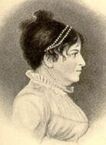 About the authoress:
About the authoress: Susanna Rowson (1762-1824) led an unconventional life while promoting high standards of female conduct and conventional morality. She was an actress at a time when, as we know, actresses were assumed to be of loose morals. When she retired from acting, she opened a female academy and operated it for 25 years, making her a successful businesswoman in addition to her other talents. She and her husband had no children--oops, well he had an illegitimate son whom she took into the household, and they also supported a number of dependent relatives. She wrote novels, plays, poems and educational books. She did charitable work for widows and orphans. Born in England, she spent most of her life in America and she was well-known in her lifetime. She published her first novel in England when she was 24 years old. She drew on her own life experience for Charlotte Temple; her father was a British officer and the family lived in America but returned to England after the Revolution. She and her husband returned to American where she became well known. A 1976 biography of Rowson makes it clear that the seduction theme, or should I say, the anti-seduction theme, appears repeatedly in her other novels. Her early (1788) novel The Inquisitor, is a sampler pack of assorted sentimental episodes (seduction, fraud and other forms of cruelty), tied together with the device of a man with a magic ring that renders him invisible. He listens in on people's conversations and who intercedes to help where he can. This passionate work is filled with Rowson's youthful animadversions on vice and folly.
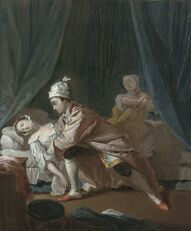 Pamela Fainting by Joseph Highmore (1743) (detail) When Charlotte Temple first came out as Charlotte, a Tale of Truth, the Critical Review wrote: “We should feel for Charlotte, if such a person ever existed, who for one error scarcely perhaps deserved so severe a punishment. If it is a fiction, poetic justice is not, we think, properly distributed.” Rowson passed up on the opportunity to punish the man as harshly as the woman for moral transgressions. In fact, Rowson does not portray Montraville as a black-hearted villain; rather, she describes him as warm-hearted and impulsive. Belcour is the actively evil one, but Montraville's story demonstrates that you can destroy another person's life by being thoughtless and selfish, even if you aren't overtly evil. He is later consumed with remorse, although its the only punishment he meets with. Rowson's narrator wished for the "power to extirpate those monsters of seduction from the earth."
Pamela Fainting by Joseph Highmore (1743) (detail) When Charlotte Temple first came out as Charlotte, a Tale of Truth, the Critical Review wrote: “We should feel for Charlotte, if such a person ever existed, who for one error scarcely perhaps deserved so severe a punishment. If it is a fiction, poetic justice is not, we think, properly distributed.” Rowson passed up on the opportunity to punish the man as harshly as the woman for moral transgressions. In fact, Rowson does not portray Montraville as a black-hearted villain; rather, she describes him as warm-hearted and impulsive. Belcour is the actively evil one, but Montraville's story demonstrates that you can destroy another person's life by being thoughtless and selfish, even if you aren't overtly evil. He is later consumed with remorse, although its the only punishment he meets with. Rowson's narrator wished for the "power to extirpate those monsters of seduction from the earth." It would seem that Rowson absolves Charlotte of responsibility for her failure to resist Montraville at the moment of crisis by having her faint into Montraville's arms when he takes her away in the carriage. But it's very much a standard thing for heroines of sentimental novels to be paralyzed and rendered incapable of acting, moving, or speaking, during moments of crisis. They keel over like Tennessee fainting goats. Think of Richardson's Pamela, fending off the advances of her employer. She fainted, too, which fortunately had the effect of shaming Mr. B. away from attempting anything.
Apart from urging girls to resist being literally carried away by smooth-tongued seducers, the most proto-feminist statement Rowson makes in Charlotte Temple is her comparison of mercenary marriage to prostitution. We often see feminist attitudes linked to Mary Wollstonecraft, as though she was the only person promoting feminist views. Scholar Veena Kasbekar notes that ‘’In her novel The Adventures of David Simple (1744) Sarah Fielding was perhaps the first feminist to call such marriages a form of legal prostitution," which is decades before Wollstonecraft. I just mean to observe that while Wollstonecraft is the most famous early feminist, she is not the fount of all feminism. Weil, Dorothy. In Defense of Women: Susanna Rowson (1762-1824). Pennsylvania State University Press, 1976.
Rust, Marion. “What's Wrong with "Charlotte Temple?".” The William and Mary Quarterly, vol. 60, no. 1, 2003, pp. 99–118.
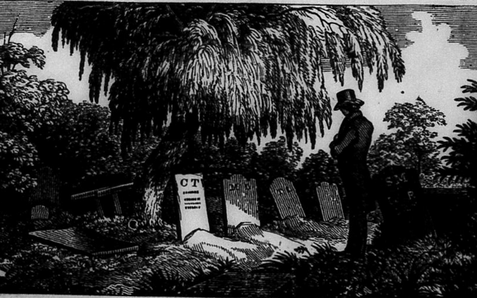 Frontispiece of 1919 edition So many people wept over the tragic fate of Charlotte Temple, that a
gravestone with her name engraved
on it was laid in the churchyard where the authoress said she was buried. The book states that Montraville often visited Charlotte's grave to shed a repentant tear. Rowson's book is also discussed in tandem with another best-selling and tragic "seduction novel," The Coquette or, The History of Eliza Wharton (1797) by Hannah Webster. The Coquette is based on the true story of a woman named Elizabeth Whitman who gave birth to an illegitimate child and subsequently died, at age 37, a surprisingly advanced age for a coquette, in my view. Another very popular seduction plot book was Mrs. Henry Wood's East Lynne (1861). Charlotte Temple, like East Lynne, was frequently dramatized as a popular stage piece. Imagine the weeping! Montraville's dramatic threat to Charlotte that he will kill himself if she doesn't elope with him deserves the flippant retort a woman gives to her unwelcome lover in Jenkin Jones's picaresque novel Unfortunate Amours (1808): You’re as welcome to die as to sleep,
Frontispiece of 1919 edition So many people wept over the tragic fate of Charlotte Temple, that a
gravestone with her name engraved
on it was laid in the churchyard where the authoress said she was buried. The book states that Montraville often visited Charlotte's grave to shed a repentant tear. Rowson's book is also discussed in tandem with another best-selling and tragic "seduction novel," The Coquette or, The History of Eliza Wharton (1797) by Hannah Webster. The Coquette is based on the true story of a woman named Elizabeth Whitman who gave birth to an illegitimate child and subsequently died, at age 37, a surprisingly advanced age for a coquette, in my view. Another very popular seduction plot book was Mrs. Henry Wood's East Lynne (1861). Charlotte Temple, like East Lynne, was frequently dramatized as a popular stage piece. Imagine the weeping! Montraville's dramatic threat to Charlotte that he will kill himself if she doesn't elope with him deserves the flippant retort a woman gives to her unwelcome lover in Jenkin Jones's picaresque novel Unfortunate Amours (1808): You’re as welcome to die as to sleep,Hang, or drown, you’ve my free will and pardon:
Sir, my fish-pond is twenty feet deep,
There are plenty of trees in my garden. Previous post: Adriana in Bath
Published on February 01, 2024 00:00
January 25, 2024
CMP#170 Adriana, the sympathetic heroine
 Clutching My Pearls is my ongoing blog series about my take on Jane Austen’s beliefs and ideas, as based on her novels. I’ve also been blogging about now-obscure authors of the long 18th century. For more, click "Authoresses" on the menu at right. Click here for the first in the series. CMP#170 Book review: A Winter in Bath (1807), by anonymous
Clutching My Pearls is my ongoing blog series about my take on Jane Austen’s beliefs and ideas, as based on her novels. I’ve also been blogging about now-obscure authors of the long 18th century. For more, click "Authoresses" on the menu at right. Click here for the first in the series. CMP#170 Book review: A Winter in Bath (1807), by anonymous
 The whirl of Bath with Catherine Morland (Felicity Jones) and Henry Tilney (JJ Feild) In previous blog posts, I discussed a sub-genre of novel called the “season” novel. This genre was invented by Thomas Skinner Surr in his A Winter in London (1806), which was such a huge mega-hit with its thinly-disguised portraits of real aristocrats and London celebrities, that many imitators followed, such as
A Summer at Weymouth (1808)
and A Season at Harrowgate (1817). This post is about A Winter in Bath, by an anonymous author, but I didn’t read this 1807 novel because it’s a “season” novel. A Winter in Bath deserves attention for a few other reasons:The publisher, Benjamin Crosby, threatened to sue another publisher who brought out a book called A Winter at Bath at the same time, a dispute which spilled over to the newspapers and the review columns.A Winter in Bath is tied to the mystery over the authorship of The Woman of Colour, the unusual 1803 novel which features a “mulatto” heiress as its main character. More about that later.There is an Emma-like reference which might be interesting to Janeites. Mrs. Elton, the daughter of a Bristol trader in Emma, boasts that she has “resources within herself” which enable her to live in obscurity in the small village of Highbury. In A Winter in Bath, we have a minor character, Mr. Oakley. He was a prosperous Bristol trader who retires and moves to live like a gentleman in the country. But he misses his old life because he’s not interested in hunting or field sports and intellectually, he is: “[d]estitute of resources, with no taste for any intellectual or refined amusement….”This novel features a lesbian couple as minor characters. Have we got your attention now, modern academy? I've read almost one hundred novels of the long 18th century, I'd place this one higher on the list than many others...
The whirl of Bath with Catherine Morland (Felicity Jones) and Henry Tilney (JJ Feild) In previous blog posts, I discussed a sub-genre of novel called the “season” novel. This genre was invented by Thomas Skinner Surr in his A Winter in London (1806), which was such a huge mega-hit with its thinly-disguised portraits of real aristocrats and London celebrities, that many imitators followed, such as
A Summer at Weymouth (1808)
and A Season at Harrowgate (1817). This post is about A Winter in Bath, by an anonymous author, but I didn’t read this 1807 novel because it’s a “season” novel. A Winter in Bath deserves attention for a few other reasons:The publisher, Benjamin Crosby, threatened to sue another publisher who brought out a book called A Winter at Bath at the same time, a dispute which spilled over to the newspapers and the review columns.A Winter in Bath is tied to the mystery over the authorship of The Woman of Colour, the unusual 1803 novel which features a “mulatto” heiress as its main character. More about that later.There is an Emma-like reference which might be interesting to Janeites. Mrs. Elton, the daughter of a Bristol trader in Emma, boasts that she has “resources within herself” which enable her to live in obscurity in the small village of Highbury. In A Winter in Bath, we have a minor character, Mr. Oakley. He was a prosperous Bristol trader who retires and moves to live like a gentleman in the country. But he misses his old life because he’s not interested in hunting or field sports and intellectually, he is: “[d]estitute of resources, with no taste for any intellectual or refined amusement….”This novel features a lesbian couple as minor characters. Have we got your attention now, modern academy? I've read almost one hundred novels of the long 18th century, I'd place this one higher on the list than many others...
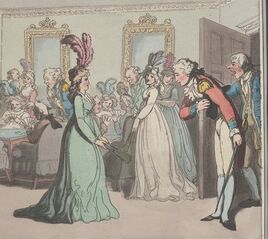 Thomas Rowlandson, "Comforts of Bath" series Scathing review
Thomas Rowlandson, "Comforts of Bath" series Scathing review A Winter in Bath received two sharply different reviews—one trashing it, and one praising it. I think the critical review was biassed and unfair. This novel is not “insipid” and “uninteresting.” It should not be “consigned to the flames.” Fine, you can take issue with the practise of putting thinly-disguised famous people into novels, (that is, people who were famous back then, I have no idea who the author is lampooning in A Winter in Bath), but the story itself is well-structured and has an appealing heroine, as sentimental heroines go.
The author arouses our sympathies from the beginning because Adriana Hartley has been neglected by her fashionable parents, who leave her for years in a remote boarding school and then summon her to London when she turns seventeen. When she arrives, eager to be reunited, she discovers they couldn’t be bothered to stay at home for her, but have both gone out for the night to separate amusements. When she wakes up early the next morning (as heroines in London always do, to the surprise of the servants), mom and dad sleep in for hours, and only give her a quick greeting before they start dressing to go out again.
Dad wants to get Adriana on the marriage market quickly, but mom is embarrassed to have it known that she, a society beauty, has a grown-up daughter, so she refers to Adriana as a "child."
 Mr. Falkland is smitten when he sees Adriana teaching a poor little girl her catechism--a primer on religious faith that children were required to memorize. Novels often showed heroines performing acts of charity. Adriana was educated by a virtuous and wise teacher, so she can’t help but see that her mom and dad lead separate but dissolute lives. But she’s too young and innocent to understand what's going on when catastrophe breaks upon them—mom runs off with another man. Her father, without explanation, swiftly packs her off to her maternal grandmother’s house in the country. The news of her daughter’s adulterous elopement reaches Mrs. Cosby before her granddaughter does, the shock kills her, and Adriana gets there only in time to say good-bye. There she is, seventeen years old, living in the country with only the servants to keep her company, and one of them is a hellfire-and-brimstone Methodist. (Methodists were often satirized and critiqued in these old novels).
Mr. Falkland is smitten when he sees Adriana teaching a poor little girl her catechism--a primer on religious faith that children were required to memorize. Novels often showed heroines performing acts of charity. Adriana was educated by a virtuous and wise teacher, so she can’t help but see that her mom and dad lead separate but dissolute lives. But she’s too young and innocent to understand what's going on when catastrophe breaks upon them—mom runs off with another man. Her father, without explanation, swiftly packs her off to her maternal grandmother’s house in the country. The news of her daughter’s adulterous elopement reaches Mrs. Cosby before her granddaughter does, the shock kills her, and Adriana gets there only in time to say good-bye. There she is, seventeen years old, living in the country with only the servants to keep her company, and one of them is a hellfire-and-brimstone Methodist. (Methodists were often satirized and critiqued in these old novels).Luckily, Mr. and Mrs. Selwyn, the local clergyman and his wife, are very kind. Through them, Adriana meets a saucy, madcap, heiress, Cecelia Oakley. It is only when she attends a ball hosted by Cecelia that Adriana overhears people gossiping about her mother—only then does she understand what has happened—only then she learns why her father has gone to France—he is tracking down his wife's seducer to challenge him to a duel, as the social rules decree. Now Adriana realizes that her mother’s scandal may affect her own reputation. Adriana also meets a nice older man, Mr. Falkland, and we learn that he was an early suitor for Adriana’s mother's hand, when she was Caroline Cosby. Caroline jilted him for the richer, city-dwelling Mr. Hartley. Falkland becomes a kind mentor figure to Adriana. She passes her time rationally in the country and—naturally for a heroine--performs acts of charity.
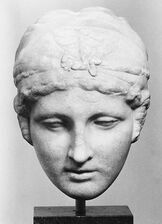 Bust of Sappho, hint, hint. (Metropolitan Museum) Bath as the backdrop
Bust of Sappho, hint, hint. (Metropolitan Museum) Bath as the backdrop As I mentioned, I think the story is not bad, as compared to other novels of this era. The author keeps the plot and sub-plots in motion. For example, the madcap heiress Cecelia is pursued by Lord Maybury, an impoverished fortune-hunter—I need hardly mention that he is Irish, of course—then he propositions Adriana, (that is, to be his mistress, not to marry him). She is disgusted at his behaviour, but events conspire to keep her from warning her friend before Cecelia marries him. Finally we get to Bath, to have our “Winter in Bath.”
Bath is a logical locale for a “season” novel about fashionable life. As scholar Amy Prendergast notes: “Bath became recognised, alongside London, as one of the most popular international marriage markets.... Bath came to provide the setting for the unfolding of various marriage plots and their contingent narrative complications, with the mixing of people from different locales... with Frances Sheridan’s play A Journey to Bath (c. 1765) and her son Richard Brinsley’s The Rivals (1775) representing key examples, alongside novels by Jane Austen, Frances Burney, and Amelia Opie.”
We get into interminable scenes of high life which have little interest for me because I don’t know who is being lampooned. Are Mrs. D’Onolly and her bosom friend Miss Filmer based on real people? Mrs. D’Onolly, says Prendergast, “embodies the caricature of the older widow travelling to Bath to ‘gain a second husband,’” but she is also a vehicle for introducing another aspect of “season” novels—the characters in them tend to discuss literature and current events. Mrs. D’Onolly fancies herself a poet and patron of the arts, and follows the “path of sentiment, philosophy, and all the theory of refinement and contradiction with which some of the modern writers have lately contrived to bewilder the brains of their fair readers.”
There are also many broad hints about Mrs. D’Onolly and Miss Filmer. “Miss Filmer constantly and unceasingly averred, that Mrs D’Onolly’s head was quite a model for the bust of Sappho; and that the glowing thoughts of the Grecian poetess were like the fine frenzied imagination of her adored D’Onolly!” Get your “interrogating” boots on, academic ladies! You’re needed to explain how this satirical portrayal of a lesbian couple in a highly didactic, overtly religious novel, is actually a sympathetic one which subverts gender norms.
 Gallery of characters in Bath life
Gallery of characters in Bath life 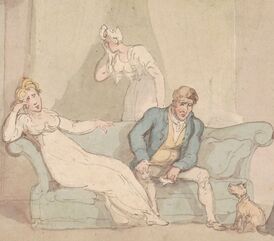 The Ruined Gamester, Thomas Rowlandson, (detail) No vortexing please, we’re heroines
The Ruined Gamester, Thomas Rowlandson, (detail) No vortexing please, we’re heroinesAdriana, being a heroine, doesn’t care for the late nights, the vortex of dissipation, the false glare and tinsel of the city. She doesn’t like the crowd the Mayburys run with: “gamblers of both sexes, half-pay officers, withered beauties, petits maitres, Irish widows, younger brothers, and every amateur singer, dancer, spouter, declaimer, pedestrian, equestrian, and boxer…” attend Lady Maybury’s entertainments and “all that was decent and respectable seemed to side off from an introduction, as if by general consent.”
Adriana’s father returns on the scene, and she realizes that he’s a compulsive gambler who has destroyed the family fortunes, and he only looks at her as a meal ticket. He plans to sell her off in marriage and he expects her to obey. The author bluntly refers to this as “legal prostitution.” Her father’s choice is a Mr. Dawson, who is a John Thorpe type of character; a stupid, clumsy oaf. There is also a passable suitor, Sir Lionel Herbert, but he abruptly disappears just before she has reason to believe he will propose. How Adriana misses her friend Mr. Falkland!
Adriana's father is compelled to put the dead grandmother’s country home up for sale. Then he disappears, leaving Adriana with nothing. Instead of being the heiress of a respectable family, she is now the penniless daughter of scandal. She faces up to this with considerable strength of character; she understands that she’ll have to look for a job. In the meantime, she moves in with Lord and Lady Maybury because she has nowhere else to go, but this is more than awkward because Lady Maybury resents Lord Maybury’s attentions to her. After he attempts outright assault on her, Adriana realizes she must get out of Bath. She resolves to sell a valuable lace veil to get money to return to the country and ask for the protection of the clergyman and his wife. This sets off a chain of events, or should I say a chain of coincidences, in which Adriana is reunited with her mother who is (a) very repentant about everything she’s done and (b) on her death-bed. Then Adriana is rescued from Bath by Mr. Falkland, who has come looking for her.
You may have guessed that Mr. Falkland is a Mr. Knightley/Colonel Brandon type—the older mentor turned lover. He is also as generous as Mr. Darcy, because it turns out he’s the purchaser of the beloved old country home. Dad, meanwhile, dies in a duel with his late wife’s lover. The unfavourable review of A Winter in Bath concludes: “After some trifling incidents, which among other things explain Sir Lionel’s conduct, the curtain drops on the marriage of Falkland with Adriana; the female readers are sent away displeased and dissatisfied with this unsuitable connection, and every reader, we will venture to say, regretting the waste of the half hour which has been spent in perusing this wretched production.” I have to think that reviewer for the Critical Review was a friend of one of the people lampooned.
The other review, much shorter, says: “The story is well written, the incidents are good, and the characters are excellently pourtrayed.” And oops!--I have learned in an article by scholar Anthony Mandal that the periodical which published the good review, Flowers of Literature, was owned by Crosby, so he is praising his own publication! The accomplished Adriana sings the Scottish ballad Roy's Wife of Aldivalloch for her father's guests. "Moral excellence"
For now, except for the soggy middle of this novel with its overextended scenes of Bath life—the giddy maze of folly and the vortex of pleasure--I would say this is a decent read with a likeable heroine. For what it’s worth, I had no objection to Mr. Falkland. He treats Adriana with respect, not condescension, and I’m sure they lived happily ever after.
Every novel has to have a moral, as the Critical Review article says: "It is the province of the novelist to mould into an agreeable fiction such events and circumstances as may illustrate the prevailing weaknesses and the peculiar virtues of human nature, and uniformly to excite the sympathy of the reader in favour of moral excellence."
In her opening, the author expresses pity for the innocent daughters whose reputations are damaged by the actions of their mothers, but she defends the unkind necessity of ostracizing the “frail sister” from society. “Such are the laws of the world—and such should they be; for these [social sanctions] operate on minds which are unaffected by religion, and contribute to keep the decencies of life from being violated…” A Winter in Bath, therefore continues my string of novels in which virtue and reputation are the paramount themes.
Previous post: Janeites know that Crosby and Co. was the publisher who bought the first version of Northanger Abbey, then titled Susan, for ten pounds, but never published it. Years later, Austen bought it back, revised it, and it was published after her death by John Murray.
Prendergast, Amy. “A Winter in Bath, 1796-97: Life Writing and the Irish Adolescent Self.” The European Journal of Life Writing, vol. 10, 2021, pp. 18–40
A. A. Mandal, "Making Austen Mad: Benjamin Crosby and the Non-Publication of Susan," The Review of English Studies, Volume 57, Issue 231, September 2006, Pages 507–525,
Stevens. (2017). "The Season Novel, 1806-1824: A Nineteenth-Century Microgenre". Victoriographies, 7(2), 81–100.
Published on January 25, 2024 00:00
January 18, 2024
CMP#169 Emily the likeable heroine
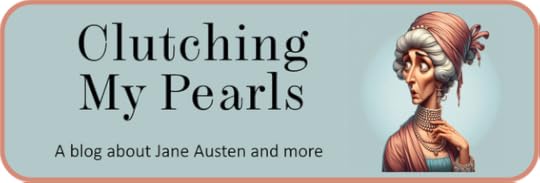 This blog explores social attitudes in Jane Austen's time, discusses her novels, reviews forgotten 18th century novels, and throws
some occasional shade
at the modern academy. The introductory post is here. My "six simple questions for academics" post is here. CMP#169 Emily Willis, or the History of a Natural Daughter (1756) by Anonymous
This blog explores social attitudes in Jane Austen's time, discusses her novels, reviews forgotten 18th century novels, and throws
some occasional shade
at the modern academy. The introductory post is here. My "six simple questions for academics" post is here. CMP#169 Emily Willis, or the History of a Natural Daughter (1756) by Anonymous
 Mrs. Martin, Robert Martin, and Harriet, the "natural daughter" of somebody I’ve been looking at novels with characters, mostly girls, who were illegitimate, such as Emma’s Harriet Smith. Harriet is the “natural daughter” of a prosperous tradesman, but scholar Lisa Zunshine notes that in novels of this era, “the overwhelming majority of temporarily displaced children” such as foundlings, were not only from good families, but were not illegitimate after all. These heroes and heroines would be "raised by strangers, leave her adopted family upon reaching marriageable age, go through numerous ordeals (during which she acquired an eligible suitor while retaining her chastity), and finally discover her true kin, reassert her legitimate status, and reestablish herself as part of her biological family.”
Mrs. Martin, Robert Martin, and Harriet, the "natural daughter" of somebody I’ve been looking at novels with characters, mostly girls, who were illegitimate, such as Emma’s Harriet Smith. Harriet is the “natural daughter” of a prosperous tradesman, but scholar Lisa Zunshine notes that in novels of this era, “the overwhelming majority of temporarily displaced children” such as foundlings, were not only from good families, but were not illegitimate after all. These heroes and heroines would be "raised by strangers, leave her adopted family upon reaching marriageable age, go through numerous ordeals (during which she acquired an eligible suitor while retaining her chastity), and finally discover her true kin, reassert her legitimate status, and reestablish herself as part of her biological family.” This has been the case in several novels, some of which I’ve reviewed here, including: Anna, or Memoirs of a Welch Heiress (1785), Fanny or the Deserted Daughter ( 1792), Edward or various views of Human Nature (1798), Glenmore Abbey (1805), and There is a Secret, Find it Out! (1808). Therefore, I wanted to check out the novel titled Eliza Willis or History of a Natural Daughter to see if Eliza really was a natural daughter, or the misplaced daughter of an Earl, as these foundlings usually turn out to be. And yes, Emily Willis discovers who her parents are, and they are both from good families. But--shocker!-- they never got married. Mom gave birth in secret and went on to marry someone else.
This novel then, presents as its heroine a girl from the wrong side of the blanket, who must contend with being treated as being sexually available on account of her low status, who nonetheless is rewarded with a wealthy baronet for her husband. It is another entry into the genre of novels which center around chastity and reputation. Tolerance and Intolerance
While some characters in the book (the fools and villains) speak disparagingly of Emily because she is illegitimate, others stand up for her. Her chief confidante and mentor, Mrs. Easy, declares: “As to your Birth, there is nothing particular in it. You are blameless…”
Clearly, the anonymous author does not believe in visiting the sins of the father (or the mother, because of course women are punished more severely than men) on the innocent child, and the story argues for kinder social attitudes towards illegitimate children.
Emily Willis is an intelligent and sensitive (but not too sentimental) heroine. We are introduced to her in a refreshingly different way; instead of leaving it all to the omniscient narrator, we see Emily through the eyes of Mrs. Easy, an intelligent widow of modest means who shares a mail coach with Emily and the family appointed to be her guardians. The Hippocrenes are presented (sometimes at over-length) as a comical family but they are also thieves who make away with Emily’s one thousand dollar inheritance from her foster-mother Mrs. Dawson. This sets up the pattern for the book, in which the brisk forward movement of the plot is interrupted by long comical dialogues between various groups of eccentric characters.
 George Elgar Hicks: Old Associations (detail) Self-sufficient heroine
George Elgar Hicks: Old Associations (detail) Self-sufficient heroineOur heroine is no shrinking violet. She wants to find a job; she knows she must work. Mrs. Easy counsels her against going into business or getting a job in a shop because she is too young and pretty: “That face of yours would subject you to a thousand Inconveniencies in such an exposed way of Life.” Mrs. Easy finds her a position as a companion in the home of the elderly and aristocratic Mrs. Freelove.
The author plays with our expectations where Mrs. Easy is concerned. Is she a panderer or is there some kind of plot afoot? Once Emily goes to Mrs. Freelove’s, Mrs. Easy no longer answers Emily’s letters—and she needs help because the usual problem which afflicts unprotected heroines arises—Emily's beauty is her curse. Because of her beauty, elegance, and charm, she is propositioned by well-born gentlemen, two of them in fact: Sir George Freelove, a baronet, and Lord B_____, an earl.
Here’s the author’s description of Sir George: “Sir George Freelove was about Three-and-twenty, and exceeding handsome; well-featur’d, well-complexion’d, and well-made; strong without awkwardness, and delicate without Effeminacy; neither a Fribble nor a Bruiser.”
Sir George had tried the good ol’ “the marriage ceremony is just priestcraft” line on Emily, but instead of fainting and weeping, Emily replied with spirit:
“'Pray, Sir, if you had a Sister in my Situation, would you chuse to have her united to a Man in an illegal Manner?'
'What have you and I to do with custom?... Come my Angel,' continued he, once more seizing her Hand, 'you was not made to be a Slave to that tyrant Custom….'
'You and I, Sir George,’ said Emily, with more Haughtiness than she had ever assumed, ‘are of a different Opinion on this Subject: I am neither to be lulled by Flattery, nor out-witted by Sophistry. I am determined to be Virtuous in the strict Acceptation of the Word…'”
Jealous servants and a jealous female house guest conspire to paint Emily as a designing adventuress, even though she resolutely turned down both men. Mrs. Freelove abruptly dismisses her.
 Austen's hypochondriac, Mary Musgrove Amazing coincidences
Austen's hypochondriac, Mary Musgrove Amazing coincidencesBack in London, Emily discovers the Hippocrenes have absconded to Ireland. Though Emily sheds a few tears at finding herself abandoned and almost penniless, she resolutely carries on, finds some work sewing shirts, and fortunately reconnects with Mrs. Easy. (It turns out a servant was lazy about checking and forwarding Mrs. Easy’s letters to her.) Mrs. Easy is a loyal friend and confidante for Emily, indeed the only one she has in the world.
Emily finds a new situation with a new comical couple--with the Hippocrenes, the joke was that they both aspired to be playwrights, the joke here is that Mrs. Languish is a hypochondriac. Emily has plenty of time to think wistfully about Sir George, the baronet, because even though she repulsed his overtures, he has won her heart. Sir George can’t forget Emily either, and he writes to her, proposing marriage. She nobly turns down the offer to escape from her life of penury because of the social gulf between them; she knows his relatives would abhor the match and she fears he himself might come to regret it one day.
Then a guest, Lady Coverley, comes to visit Mr. and Mrs. Languish. She falls ill, and Emily helps nurse her. When Lady Coverley learns Emily was raised by a woman named Mrs. Dawson, she confesses that she (Lady Coverley, that is) is Emily’s mother! Admitting to her early indiscretion is enough to send Mrs. Coverley raving mad with remorse and guilt, and then she dies. At least Emily has learned the name of her father--Melvile-- though she has lost her mother. By punishing Lady Coverley with death, the author condemns the creation of illegitimate children without placing the stigma on the child.
Emily’s nerves have had quite a shock, so she resigns her job and finds another home with an old schoolfellow who is on the point of marriage with Mr. Frankair. Emily becomes their permanent houseguest, and thereby meets the neighbours, including Colonel Melvile, a wealthy man in his mid-forties. Melvile, did you say?
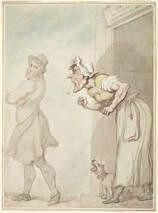 A smoky chimney and a scolding wife, Rowlandson Okay... If you were Emily, how long would you wait before asking Colonel Melvile a few leading questions? Emily doesn’t ask any questions, she’s too abashed. She and the colonel become closer and friendlier until one day (eee-yew), he asks her to marry him. Only then does she tell him: “My mother’s name was Harriot R____” and he realizes who she is. Quick switching of gears here to paternal love: “You are my Child indeed.” Emily's father Colonel Melvile is quite conveniently rich, which was not the case when he and Harriet R____ wanted to get married.
A smoky chimney and a scolding wife, Rowlandson Okay... If you were Emily, how long would you wait before asking Colonel Melvile a few leading questions? Emily doesn’t ask any questions, she’s too abashed. She and the colonel become closer and friendlier until one day (eee-yew), he asks her to marry him. Only then does she tell him: “My mother’s name was Harriot R____” and he realizes who she is. Quick switching of gears here to paternal love: “You are my Child indeed.” Emily's father Colonel Melvile is quite conveniently rich, which was not the case when he and Harriet R____ wanted to get married.Emily’s aunt-in-law and one of her cousins are greatly disappointed when their rich, single, uncle suddenly has an heir, and they object on the grounds of her illegitimacy: “’Aye’, said my Lady, ‘it will bring a pretty Scandal on the Family indeed’…’See her indeed,’ said Jenny, ‘No... I hope you will never consent to that, I dare say she’s an impudent Thing, and not fit to keep us Company.’ ‘No Child,’ said my Lady, ‘I hope I have given you a better Education, than to make you Company for such Wretches: But your Father’s a Fool, and wants to make one of me…’” (Aunt Melvile is one of three wives in this story who openly disparage and quarrel with their husband, which to me provides a counterpoint to the ‘women are slaves of the patriarchy’ interpretations of the past).
Now that Emily is an heiress and recognized by her father, she can accept Sir George’s proposal of marriage. Sir George handsomely declares that he was attracted to her for her beauty but fell in love with her mind and has been reformed by her principles. Emily pardons everyone who has wrong her. Mrs. Freelove, the aunt of the baronet, is so impressed that she gives her blessing with thee/thou pronouns: “thou art worthy to be my Niece—thy illegitimacy shall be no Obstacle, since thy Father and Mother sprung from such good Families.” We finish off with a wedding, and a comical reintroduction of the Hippocrenes, who are down on their luck.
Final thoughts
This was probably my favorite foundling story that I’ve read so far. We can also categorize it as “reformed rake” story because Sir George was adamantly opposed to marriage before he met Emily, but he transformed into a love-sick swain. He also indignantly rejects a friend who suggests that he slip some laudanum in Emily’s wine and have his way with her. Their conversation is one which I will not repeat here, as it was rather shockingly graphic as compared to Austen.
In Emma, Harriet Smith, with only beauty and a sweet manner to recommend her, could not aspire to marriage to a baronet, as even Emma must acknowledge once it is revealed that she is a tradesman's daughter: “Such was the blood of gentility which Emma had formerly been so ready to vouch for!—It was likely to be as untainted, perhaps, as the blood of many a gentleman: but what a connexion had she been preparing for Mr. Knightley—or for the Churchills—or even for Mr. Elton!—The stain of illegitimacy, unbleached by nobility or wealth, would have been a stain indeed.” Emily has both the nobility and wealth, not to mention the genteel education, that Harriet lacks.
At any rate, this is one 18th century novel that I would recommend reading for pleasure, as opposed to purely for research, even if the comic dialogues went on too long for my liking; the writer handled her/her story well and her heroine is sympathetic and likeable. About the author:
So far as I know, the true identity of the anonymous author has never been discovered. S/he also wrote: Memoirs of a Coquet; Or the History of Miss Harriot Airy (1765). Emily Willis stayed in print for several decades. Emily Willis is not to be confused with the 1799 novel The natural daughter: with portraits of the Leadenhead family.
As I mentioned, we meet an assortment of characters who sport various faults and foibles who engage in extended dialogues. This gallery of grotesques, says The Critical Review, are “such as common life daily furnishes, [though] that of Hippocrene and his wife are strained rather a little too high.” However, the reviewer commends the “natural manner” of these commentaries in the story.
Zunshine, Lisa. Bastards and Foundlings: Illegitimacy in Eighteenth-century England. Ohio State University Press, 2005.
Previous post: Clouds of Mystery
Published on January 18, 2024 00:00



